
- Oct 13, 2019

10 Steps to Problem Solving for Engineers
Updated: Dec 6, 2020
With the official launch of the engineering book 10+1 Steps to Problem Solving: An Engineer's Guide it may be interesting to know that formalization of the concept began in episode 2 of the Engineering IRL Podcast back in July 2018.
As noted in the book remnants of the steps had existed throughout my career and in this episode I actually recorded the episode off the top of my head.
My goal was to help engineers build a practical approach to problem solving.
Have a listen.
Who can advise on the best approach to problem solving other than the professional problem solvers - Yes. I'm talking about being an Engineer.
There are 2 main trains of thought with Engineering work for non-engineers and that's trying to change the world with leading edge tech and innovations, or plain old boring math nerd type things.
Whilst, somewhat the case what this means is most content I read around Tech and Engineering are either super technical and (excruciatingly) detailed. OR really riff raff at the high level reveling at the possibilities of changing the world as we know it. And so what we end up with is a base (engineer only details) and the topping (media innovation coverage) but what about the meat? The contents?
There's a lot of beauty and interesting things there too. And what's the centrepiece? The common ground between all engineers? Problem solving.
The number one thing an Engineer does is problem solving. Now you may say, "hey, that's the same as my profession" - well this would be true for virtually every single profession on earth. This is not saying there isn't problem solving required in other professions. Some problems require very basic problem solving techniques such is used in every day life, but sometimes problems get more complicated, maybe they involve other parties, maybe its a specific quirk of the system in a specific scenario. One thing you learn in engineering is that not all problems are equal. These are
The stages of problem solving like a pro:
Is the problem identified (no, really, are you actually asking the right question?)
Have you applied related troubleshooting step to above problem?
Have you applied basic troubleshooting steps (i.e. check if its plugged in, turned it on and off again, checked your basics)
Tried step 2 again? (Desperation seeps in, but check your bases)
Asked a colleague or someone else that may have dealt with your problem? (50/50 at this point)
Asked DR. Google (This is still ok)
Deployed RTFM protocol (Read the F***ing Manual - Engineers are notorious for not doing this)
Repeated tests, changing slight things, checking relation to time, or number of people, or location or environment (we are getting DEEP now)
Go to the bottom level, in networking this is packet sniffers to inspect packets, in systems this is taking systems apart and testing in isolation, in software this is checking if 1 equals 1, you are trying to prove basic human facts that everyone knows. If 1 is not equal to 1, you're in deep trouble.At this point you are at rebuild from scratch, re install, start again as your answer (extremely expensive, very rare)
And there you have it! Those are your levels of problem solving. As you go through each step, the more expensive the problem is. -- BUT WAIT. I picked something up along the way and this is where I typically thrive. Somewhere between problem solving step 8 and 10.

The secret step
My recommendation at this point is to try tests that are seemingly unrelated to anything to do with the problem at all.Pull a random cable, test with a random system off/on, try it at a specific time of the day, try it specifically after restarting or replugging something in. Now, not completely random but within some sort of scope. These test are the ones that when someone is having a problem when you suggest they say "that shouldn't fix the problem, that shouldn't be related" and they are absolutely correct.But here's the thing -- at this stage they have already tried everything that SHOULD fix the problem. Now it's time for the hail mary's, the long shots, the clutching at straws. This method works wonders for many reasons. 1. You really are trying to try "anything" at this point.
2. Most of the time we may think we have problem solving step number 1 covered, but we really don't.
3. Triggering correlations.
This is important.
Triggering correlations
In a later post I will cover correlation vs causation, but for now understand that sometimes all you want to do is throw in new inputs to the system or problem you are solving in order to get clues or re identify problems or give new ways to approach earlier problem solving steps. There you have it. Problem solve like a ninja. Approach that extremely experienced and smart person what their problem and as they describe all the things they've tried, throw in a random thing they haven't tried. And when they say, well that shouldn't fix it, you ask them, well if you've exhausted everything that should have worked, this is the time to try things that shouldn't. Either they will think of more tests they haven't considered so as to avoid doing your preposterous idea OR they try it and get a new clue to their problem. Heck, at worst they confirm that they do know SOMETHING about the system.
Go out and problem solve ! As always, thanks for reading and good luck with all of your side hustles.
If you prefer to listen to learn we got you covered with the Engineering IRL show!
For Youtube please go to:
https://youtu.be/EHaRNZhqmHA
For Spotify please go to:
https://open.spotify.com/show/3UZPfOvNwQkaCA1jLIOxp4
And don't forget to subscribe if you get any value from the Engineering IRL Content
- Technical Tactics
- 10+1 Steps to Problem Solving
Recent Posts
How to Implement OSHA’s Requirement of Emergency Medical Services in Construction
Preventing Noise-Induced Issues in Construction
The Advantages of CAD for Modern Engineers
Get your free Engineering Toolkit for Engineering IRL listeners only

Get a copy of the Operational Technology Ultimate Guide for Engineers e-book for free.

- school Campus Bookshelves
- menu_book Bookshelves
- perm_media Learning Objects
- login Login
- how_to_reg Request Instructor Account
- hub Instructor Commons
Margin Size
- Download Page (PDF)
- Download Full Book (PDF)
- Periodic Table
- Physics Constants
- Scientific Calculator
- Reference & Cite
- Tools expand_more
- Readability
selected template will load here
This action is not available.

1.7: Problem Solving Process
- Last updated
- Save as PDF
- Page ID 91453
\( \newcommand{\vecs}[1]{\overset { \scriptstyle \rightharpoonup} {\mathbf{#1}} } \)
\( \newcommand{\vecd}[1]{\overset{-\!-\!\rightharpoonup}{\vphantom{a}\smash {#1}}} \)
\( \newcommand{\id}{\mathrm{id}}\) \( \newcommand{\Span}{\mathrm{span}}\)
( \newcommand{\kernel}{\mathrm{null}\,}\) \( \newcommand{\range}{\mathrm{range}\,}\)
\( \newcommand{\RealPart}{\mathrm{Re}}\) \( \newcommand{\ImaginaryPart}{\mathrm{Im}}\)
\( \newcommand{\Argument}{\mathrm{Arg}}\) \( \newcommand{\norm}[1]{\| #1 \|}\)
\( \newcommand{\inner}[2]{\langle #1, #2 \rangle}\)
\( \newcommand{\Span}{\mathrm{span}}\)
\( \newcommand{\id}{\mathrm{id}}\)
\( \newcommand{\kernel}{\mathrm{null}\,}\)
\( \newcommand{\range}{\mathrm{range}\,}\)
\( \newcommand{\RealPart}{\mathrm{Re}}\)
\( \newcommand{\ImaginaryPart}{\mathrm{Im}}\)
\( \newcommand{\Argument}{\mathrm{Arg}}\)
\( \newcommand{\norm}[1]{\| #1 \|}\)
\( \newcommand{\Span}{\mathrm{span}}\) \( \newcommand{\AA}{\unicode[.8,0]{x212B}}\)
\( \newcommand{\vectorA}[1]{\vec{#1}} % arrow\)
\( \newcommand{\vectorAt}[1]{\vec{\text{#1}}} % arrow\)
\( \newcommand{\vectorB}[1]{\overset { \scriptstyle \rightharpoonup} {\mathbf{#1}} } \)
\( \newcommand{\vectorC}[1]{\textbf{#1}} \)
\( \newcommand{\vectorD}[1]{\overrightarrow{#1}} \)
\( \newcommand{\vectorDt}[1]{\overrightarrow{\text{#1}}} \)
\( \newcommand{\vectE}[1]{\overset{-\!-\!\rightharpoonup}{\vphantom{a}\smash{\mathbf {#1}}}} \)
Learning how to use a structured problem solving process will help you to be more organized and support your future courses. Also, it will train your brain how to approach problems. Just like basketball players practice jump shots over and over to train their body how to act in high pressure scenarios, if you are comfortable and familiar with a structured problem solving process, when you’re in a high pressure situation like a test, you can just jump into the problem like muscle memory.
6 Step Problem Solving Method:
- Write out the answer with all necessary information that is given to you. It feels like it takes forever, but it’s important to have the problem and solution next to each other.
- Draw the problem, this is usually a free-body diagram (don’t forget a coordinate frame). Eventually, as you get further into the course, you might need a few drawings. One would be a quick sketch of the problem in the real world, then modelling it into a simplified engineering drawing, and finally the free-body diagram.
- Write out a list of the known/given values with the variable and unit, i.e m = 14 kg (variable = number unit)
- Write out a list of the unknown values that you will have to solve for in order to solve the problem
- You can also add any assumptions you made here that change the problem.
- Also state any constants, i.e. g = 32.2 ft/m 2 or g = 9.81 m/s 2
- This step helps you to have all of the information in one place when you solve the problem. It’s also important because each number should include units, so you can see if the units match or if you need to convert some numbers so they are all in English or SI. This also gives you the variables side by side to ensure they are unique (so you don’t accidentally have 2 ‘d’ variables and can rename one with a subscript).
- Write a simple sentence or phrase explaining what method/approach you will be using to solve the problem.
- For example: ‘use method of joints’, or equilibrium equations for a rigid body, MMOI for a certain shape, etc.
- This is going to be more important when you get to the later chapters and especially next semester in Dynamics where you can solve the same problem many ways. Might as well practice now!
- This is the actual solving step. This is where you show all the work you have done to solve the problem.
- When you get an answer, restate the variable you are solving for, include the unit, and put a box around the answer.
- Write a simple sentence explaining why (or why not) your answer makes sense. Use logic and common sense for this step.
- When possible, use a second quick numerical analysis to verify your answer. This is the “gut check” to do a quick calculation to ensure your answer is reasonable.
- This is the most confusing step as students often don’t know what to put here and up just writing ‘The number looks reasonable’. This step is vitally important to help you learn how to think about your answer. What does that number mean? What is it close to? For example, if you find that x = 4000 m, that’s a very large distance! In the review, I would say, ‘the object is 4 km long which is reasonable for a long bridge’. See how this is compared to something similar? Or you could do a second calculation to verify the number is correct, such as adding up multiple parts of the problem to confirm the total length is accurate i.e. ‘x + y + z = total, yes it works!’
Additional notes for this course:
- It’s important to include the number and label the steps so it’s clear what you’re doing, as shown in the example below.
- It’s okay if you make mistakes, just put a line through it and keep going.
- Remember your header should include your name, the page number, total number of pages, the course number, and the assignment number. If a problem spans a number of pages, you should include it in the header too.
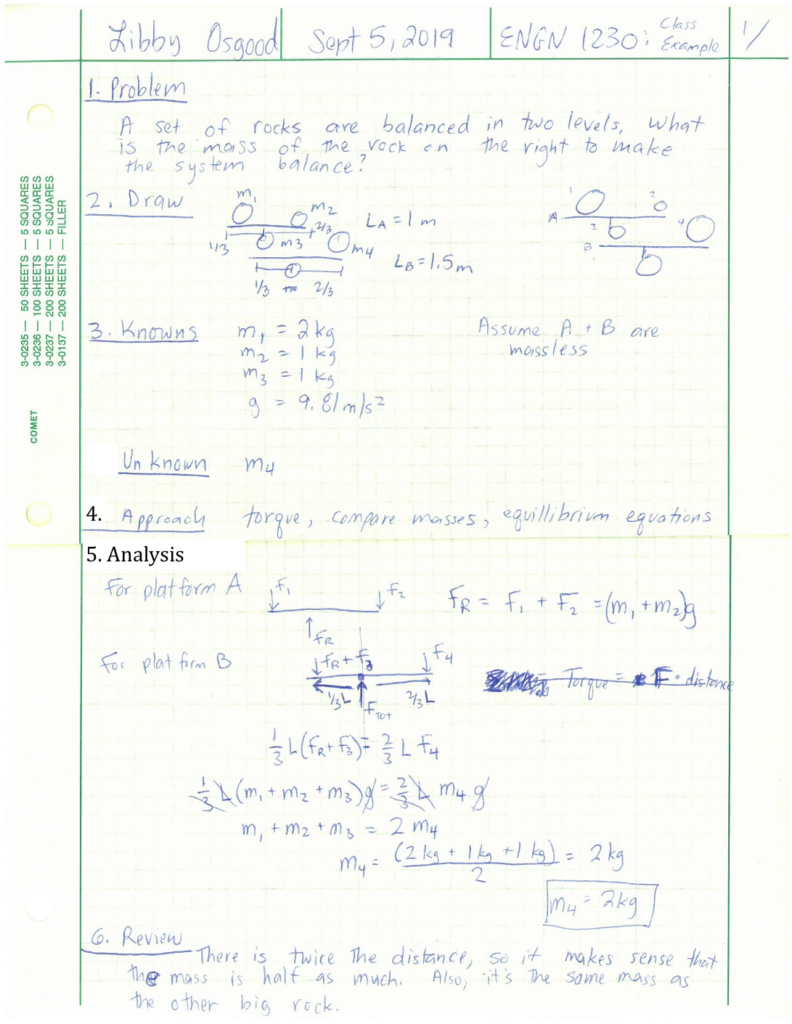
Key Takeaways
Basically: Use a 6-step structured problem solving process: 1. Problem, 2. Draw, 3. Known & Unknown, 4. Approach, 5. Analysis (Solve), 6. Review
Application: In your future job there is likely a structure for analysis reports that will be used. Each company has a different approach, but most have a standard that should be followed. This is good practice.
Looking ahead: This will be part of every homework assignment.
Written by Gayla & Libby
Engineering Problem-Solving
- First Online: 21 September 2022
Cite this chapter

- Michelle Blum 2
563 Accesses
You are becoming an engineer to become a problem solver. That is why employers will hire you. Since problem-solving is an essential portion of the engineering profession, it is necessary to learn approaches that will lead to an acceptable resolution. In real-life, the problems engineers solve can vary from simple single solution problems to complex opened ended ones. Whether simple or complex, problem-solving involves knowledge, experience, and creativity. In college, you will learn prescribed processes you can follow to improve your problem-solving abilities. Also, you will be required to solve an immense amount of practice and homework problems to give you experience in problem-solving. This chapter introduces problem analysis, organization, and presentation in the context of the problems you will solve throughout your undergraduate education.
This is a preview of subscription content, log in via an institution to check access.
Access this chapter
- Available as EPUB and PDF
- Read on any device
- Instant download
- Own it forever
- Compact, lightweight edition
- Dispatched in 3 to 5 business days
- Free shipping worldwide - see info
- Durable hardcover edition
Tax calculation will be finalised at checkout
Purchases are for personal use only
Institutional subscriptions
https://www.merriam-webster.com/dictionary , viewed June 3, 2021.
Mark Thomas Holtzapple, W. Dan Reece (2000), Foundations of Engineering, McGraw-Hill, New York, New York, ISBN:978-0-07-029706-7.
Google Scholar
Aide, A.R., Jenison R.D., Mickelson, S.K., Northup, L.L., Engineering Fundamentals and Problem Solving, McGraw-Hill, New York, NY, ISBN: 978-0-07-338591-4.
Download references
Author information
Authors and affiliations.
Syracuse University, Syracuse, NY, USA
Michelle Blum
You can also search for this author in PubMed Google Scholar
End of Chapter Problems
1.1 ibl questions.
IBL1: Using standard problem-solving technique, answer the following questions
If you run in a straight line at a velocity of 10 mph in a direction of 35 degree North of East, draw the vector representation of your path (hint: use a compass legend to help create your coordinate system)
If you run in a straight line at a velocity of 10 mph in a direction of 35 degree North of East, explain how to calculate the velocity you ran in the north direction.
If you run in a straight line at a velocity of 10 mph in a direction of 35 degree North of East, explain how to calculate the velocity you ran in the east direction.
If you run in a straight line at a velocity of 10 mph in a direction of 35 degree North of East, explain how to calculate how far you ran in the north direction.
If you run in a straight line at a velocity of 10 mph in a direction of 35 degree North of East, explain how to calculate how far you ran in the east direction.
If you run in a straight line at a velocity of 10 mph in a direction of 35 degree North of East, how far north have you traveled in 5 min?
If you run in a straight line at a velocity of 10 mph in a direction of 35 degree North of East, how far east have you traveled in 5 min?
What type of problem did you solve?
IBL2: For the following scenarios, explain what type of problem it is that needs to be solved.
Scientists hypothesize that PFAS chemicals in lawn care products are leading to an increase in toxic algae blooms in lakes during summer weather.
An engineer notices that a manufacturing machine motor hums every time the fluorescent floor lights are turned on.
The U.N. warns that food production must be increased by 60% by 2050 to keep up with population growth demand.
Engineers are working to identify and create viable alternative energy sources to combat climate change.
1.2 Practice Problems
Make sure all problems are written up using appropriate problem-solving technique and presentation.
The principle of conservation of energy states that the sum of the kinetic energy and potential energy of the initial and final states of an object is the same. If an engineering student was riding in a 200 kg roller coaster car that started from rest at 10 m above the ground, what is the velocity of the car when it drops to 2.5 m above the ground?
Archimedes’ principle states that the total mass of a floating object equals the mass of the fluid displaced by the object. A 45 cm cylindrical buoy is floating vertically in the water. If the water density is 1.00 g/cm 3 and the buoy plastic has a density of 0.92 g/cm 3 determine the length of the buoy that is not submerged underwater.
A student throws their textbook off a bridge that is 30 ft high. How long would it take before the book hits the ground?
Rights and permissions
Reprints and permissions
Copyright information
© 2022 Springer Nature Switzerland AG
About this chapter
Blum, M. (2022). Engineering Problem-Solving. In: An Inquiry-Based Introduction to Engineering. Springer, Cham. https://doi.org/10.1007/978-3-030-91471-4_6
Download citation
DOI : https://doi.org/10.1007/978-3-030-91471-4_6
Published : 21 September 2022
Publisher Name : Springer, Cham
Print ISBN : 978-3-030-91470-7
Online ISBN : 978-3-030-91471-4
eBook Packages : Engineering Engineering (R0)
Share this chapter
Anyone you share the following link with will be able to read this content:
Sorry, a shareable link is not currently available for this article.
Provided by the Springer Nature SharedIt content-sharing initiative
- Publish with us
Policies and ethics
- Find a journal
- Track your research
- What is Chemical and Biological Engineering?
- Engineering problem solving
- Error and uncertainty
- Process variables
- Process Fundamentals
- Material Balances
- Reacting systems
- Reaction kinetics
- Reactor design
- Bioreactors
- Fluids and fluid flow
- Mass transfer
- Energy balances
- Heat transfer
- Heat exchangers
- Mechanical energy balances
- Process safety
- Engineering ethics
- Sustainability
- Engineering in a global context
- How ‘good’ a solution do you need
- Steps in solving well-defined engineering process problems, including textbook problems
- « What is Chemi...
- Teamwork »
Engineering Problem Solving ¶
Some problems are so complex that you have to be highly intelligent and well-informed just to be undecided about them. —Laurence J. Peter
Steps in solving ‘real world’ engineering problems ¶
The following are the steps as enumerated in your textbook:
Collaboratively define the problem
List possible solutions
Evaluate and rank the possible solutions
Develop a detailed plan for the most attractive solution(s)
Re-evaluate the plan to check desirability
Implement the plan
Check the results
A critical part of the analysis process is the ‘last’ step: checking and verifying the results.
Depending on the circumstances, errors in an analysis, procedure, or implementation can have significant, adverse consequences (NASA Mars orbiter crash, Bhopal chemical leak tragedy, Hubble telescope vision issue, Y2K fiasco, BP oil rig blowout, …).
In a practical sense, these checks must be part of a comprehensive risk management strategy.
My experience with problem solving in industry was pretty close to this, though encumbered by numerous business practices (e.g., ‘go/no-go’ tollgates, complex approval processes and procedures).
In addition, solving problems in the ‘real world’ requires a multidisciplinary effort, involving people with various expertise: engineering, manufacturing, supply chain, legal, marketing, product service and warranty, …
Exercise: Problem solving
Step 3 above refers to ranking of alternatives.
Think of an existing product of interest.
What do you think was ranked highest when the product was developed?
Consider what would have happened if a different ranking was used. What would have changed about the product?
Brainstorm ideas with the students around you.
Defining problems collaboratively ¶
Especially in light of global engineering , we need to consider different perspectives as we define our problem. Let’s break the procedure down into steps:
Identify each perspective that is involved in the decision you face. Remember that problems often mean different things in different perspectives. Relevant differences might include national expectations, organizational positions, disciplines, career trajectories, etc. Consider using the mnemonic device “Location, Knowledge, and Desire.”
Location : Who is defining the problem? Where are they located or how are they positioned? How do they get in their positions? Do you know anything about the history of their positions, and what led to the particular configuration of positions you have today on the job? Where are the key boundaries among different types of groups, and where are the alliances?
Knowledge : What forms of knowledge do the representatives of each perspective have? How do they understand the problem at hand? What are their assumptions? From what sources did they gain their knowledge? How did their knowledge evolve?
Desire : What do the proponents of each perspective want? What are their objectives? How do these desires develop? Where are they trying to go? Learn what you can about the history of the issue at hand. Who might have gained or lost ground in previous encounters? How does each perspective view itself at present in relation to those it envisions as relevant to its future?
As formal problem definitions emerge, ask “Whose definition is this?” Remember that “defining the problem clearly” may very well assert one perspective at the expense of others. Once we think about problem solving in relation to people, we can begin to see that the very act of drawing a boundary around a problem has non-technical, or political dimensions, depending on who controls the definition, because someone gains a little power and someone loses a little power.
Map what alternative problem definitions mean to different participants. More than likely you will best understand problem definitions that fit your perspective. But ask “Does it fit other perspectives as well?” Look at those who hold Perspective A. Does your definition fit their location, their knowledge, and their desires? Now turn to those who hold Perspective B. Does your definition fit their location, knowledge, and desires? Completing this step is difficult because it requires stepping outside of one’s own perspective and attempting to understand the problem in terms of different perspectives.
To the extent you encounter disagreement or conclude that the achievement of it is insufficient, begin asking yourself the following: How might I adapt my problem definition to take account of other perspectives out there? Is there some way of accommodating myself to other perspectives rather than just demanding that the others simply recognize the inherent value and rationality of mine? Is there room for compromise among contrasting perspectives?
How ‘good’ a solution do you need ¶
There is also an important aspect of real-world problem solving that is rarely articulated and that is the idea that the ‘quality’ of the analysis and the resources expended should be dependent on the context.
This is difficult to assess without some experience in the particular environment.
How ‘Good’ a Solution Do You Need?
Some rough examples:
10 second answer (answering a question at a meeting in front of your manager or vice president)
10 minute answer (answering a quick question from a colleague)
10 hour answer (answering a request from an important customer)
10 day answer (assembling information as part of a trouble-shooting team)
10 month answer (putting together a comprehensive portfolio of information as part of the design for a new $200,000,000 chemical plant)
Steps in solving well-defined engineering process problems, including textbook problems ¶
Essential steps:
Carefully read the problem statement (perhaps repeatedly) until you understand exactly the scenario and what is being asked.
Translate elements of the word problem to symbols. Also, look for key words that may convey additional information, e.g., ‘steady state’, ‘constant density’, ‘isothermal’. Make note of this additional information on your work page.
Draw a diagram. This can generally be a simple block diagram showing all the input, output, and connecting streams.
Write all known quantities (flow rates, densities, etc.) from step 2 in the appropriate locations on, or near, the diagram. If symbols are used to designate known quantities, include those symbols.
Identify and assign symbols to all unknown quantities and write them in the appropriate locations on, or near, the diagram.
Construct the relevant equation(s). These could be material balances, energy balances, rate equations, etc.
Write down all equations in their general forms. Don’t simplify anything yet.
Discard terms that are equal to zero (or are assumed negligible) for your specific problem and write the simplified equations.
Replace remaining terms with more convenient forms (because of the given information or selected symbols).
Construct equations to express other known relationships between variables, e.g., relationships between stoichiometric coefficients, the sum of species mass fractions must be one.
Whenever possible, solve the equations for the unknown(s) algebraically .
Convert the units of your variables as needed to have a consistent set across your equations.
Substitute these values into the equation(s) from step 7 to get numerical results.
Check your answer.
Does it make sense?
Are the units of the answer correct?
Is the answer consistent with other information you have?
Exercise: Checking results
How do you know your answer is right and that your analysis is correct?
This may be relatively easy for a homework problem, but what about your analysis for an ill-defined ‘real-world’ problem?
Problem Identification in Engineering Design
Problem identification is the first step of the engineering problem solving method. The relevant themes, processes and techniques for electrical engineering and their application to the senior design project are presented here.
Theory and Background
Engineering is a profession of applied science. Engineers must creatively find new ways to solve problems, and are always real-world problems. As a result, they are usually more complex than most problems studied in school, since many of the assumptions that are made to illustrate a concept are no longer valid. Yet, engineers still must come up with some solution. With so many new factors to consider when forming a solution, the entire process may seem daunting. In this way, one of the most critical steps in the problem solving process is solid problem identification. By effectively identifying the exact problem, and engineer may limit his or her focus to only the factors required to solve that problem (Shaw, 2001).
When inexperienced students go about the problem solving process, there are several paths they might take. For example, suppose students are building some type of robot. They have wired all their circuits together, but upon testing the robot, it simply does not work. The worst path they could take in this problem solving situation is to place all the blame upon factors out of their control. “The wires we have are faulty, so there is nothing we can do.” While this might be the case, it should be the last resort, as it leads to giving up on all prior work.
More motivated students might check several parts of their design and tinker with it until it works. This ad-hoc method is most common. The students can recall different ideas they have heard might cause problems, and check each one sequentially until a solution is found. In this manner, the problem identification is melded directly to the solution, as finding the latter leads to discovering the former. The difficulty with this ad-hoc method is that it varies with each project, so a more general system to fix problems cannot be extracted from this.
The best students may look at generalized problem solving methods that have been studied and improved upon for decades, and find a way to apply it to their project. This is the path that we will examine, and to do so, we will look at several example methods.
Common Themes
The similarities among the problem solving methods can be seen across many industries, especially business. Even with no scientific or technical aspects to a situation, the same ideas identify the problems effectively. One main cause for the similarities is the desire in business and other fields to have a rigorous methodology aimed at improving the target idea, project, company, etc.
To look at some common themes in problem solving methods, we will compare four widely used techniques: the TRIZ method, Root Cause Failure Analysis, and the two methods described in How to Solve It by Pólya (1957).
TRIZ Method
TRIZ, which is a Russian acronym for Theory of Inventive Problem Solving , is a problem solving method based on the study of patterns in problems and solutions. The developers of this method have analyzed over three million inventions with the intent of predicting where breakthroughs will come from (Jugulum & Samuel, 2008). The idea is that problems and solutions are repeated across a wide variety of applications, so by generalizing the problem, one can find a proven solution. Once the abstracted problem has been solved, the solution must then be adapted to the specific situation.
This method, like many other problem solving methods, is an iterative process. Identifying the problem is the first step. Once all the TRIZ analysis tools have been used and a solution has been identified, the process cycles back to identification again. Any new factors that arise from the initial solution must be addressed and attacked in the same manner as the original situation.
The main tool of classical TRIZ analysis for problem definition is the contradiction matrix. The axes of the matrix are engineering parameters, and potential general solutions are filled in the boxes. When one solution leads to a larger problem, a contradiction is identified. Kutz describes the tool:
The objective of the matrix is to direct the problem-solving process to incorporate an idea that has been utilized before to solve an analogous ‘‘inventive’’ problem. The contradiction matrix accomplishes this by asking two simple questions: Which element of the system is in need of improvement? If improved, which element of the system is deteriorated?” (Kutz, 2006, p. 622)
This is a useful tool if the design process is certain to be a long and iterative one. By going through such exhaustive planning and searching in the beginning, one can cut down many iterations in the process. However, the tool falls short if the scope is problem. It simply may not be necessary to write out the entire matrix for a problem that has only a few clear parameters to it.
Root Cause Failure Analysis
In reliability engineering and quality control, the main objective is to deal with problems and failures. It seems clear that a systematic approach to identifying the problem would arise in this field. This is the aim of Root Cause Failure Analysis (RFCA) (Mobley, 1999). The main idea is to identify the root cause of the problem that arises and eliminate it, as opposed to waiting for effects and mitigating them. It is analogous to getting vaccinated for the flu instead of waiting to catch it and then buying tissues.
There are several analysis techniques used in RFCA. These include Failure Mode and Effects Analysis, Cause and Effect Analysis, also known as fishbone analysis, and Sequence of Events Analysis. The applicability of each technique depends on what type of problem is present and what you want to focus on. For example, when the problem arose over time, the sequence analysis might be best. Alternatively, when you just want to lay out all possible causes without giving weight to any, the fishbone analysis is useful. A diagram of fishbone analysis is shown in Figure 1.
Fishbone Analysis.
The main issue unique to RFCA is the high cost of performing such an analysis (Mobley,1999). This means it should be used only when it is absolutely necessary. Also, it is somewhat limited in scope, as it was originally designed for use in chemical plant analysis.
How to Solve It
The book How to Solve It , written in 1957 by mathematician George Pólya, gives the methods used to solve many math problems and abstracts them to general problems. He generally describes the steps as understanding the problem, making a plan, carrying it out, and analyzing.
One of the most useful ideas he puts forth that is widely used in mathematics is to find an analogous problem and solve it. This is more useful in the extremely abstract world of mathematics where assumptions always hold true and objects are perfect, but the technique can be used to get a good approximation of a real world problem. In the world of engineering, this may be sufficient to get the job done.
While the techniques outlined in the book are very interesting to me as a mathematician, there are times when the methods can fall short. It is good practice to see how rigorous problem identifications and solutions can be generalized, but that is the majority of what the method does. To go out and solve your specific problem, there are still many specific connections to be made.
Application to Senior Project
The problem identification process is critical to the senior design project’s success. Before any design, implementation, or even productive planning can be done, the central problems behind the project must be laid out. This process goes hand in hand with identifying customer specifications. It is always critical to know precisely what the customer wants; however, in the ECE senior design projects , where student have essentially no prior experience, this step should get special care. See Ulrich & Eppinger (2004) for more information on customer specifications.
Once the customer’s needs and desires have been finalized, the problem identification may begin. There will almost certainly be multiple areas of the project that have a main problem. As you look at all the items the customer has suggested or demanded, you may find contradicting qualities. Here is where breaking the problem down to its most basic form is crucial. Only then can engineering decisions be made about which areas to compromise for the good of the whole project.
While the customer specification process only should occur once, the problem identification occurs many times as the design process is iterated. For example, in the Red Team’s senior project , which involved modifying a Parrot AR Drone toy helicopter to be able to autonomously collect data, the first major problem was finding usable and inexpensive hardware to add (Video 1). Once that had been solved, the next problem area was designing software that would allow the drone to hover stably at a target. Initially these two problems appeared to be the largest challenges; however, upon completing preliminary testing, it was discovered that no matter how sophisticated the stabilizing algorithm became, the helicopter would not remain very stable. As a result, the problem solving branched out in a direction previously unexpected. The process of identifying this new problem led to a workable solution.
The Red Team’s autonomous drone project navigating and gathering data. Source: Tufts SPARTN Channel on YouTube.com.
Cited References
- Jugulum, R., & Samuel, P. (2008). Design for Lean Six Sigma – A Holistic Approach to Design and Innovation . Hoboken: John Wiley & Sons. OCLC WorldCat Permalink: http://www.worldcat.org/oclc/637224080
- Kutz, M. (2006). Mechanical Engineers’ Handbook – Materials and Mechanical Design (3rd ed.). Hoboken: John Wiley & Sons. OCLC WorldCat Permalink: http://www.worldcat.org/oclc/59003354
- Mobley, R.K. (1999). Root Cause Failure Analysis . Boston: Newnes/Elsevier. OCLC WorldCat Permalink: http://www.worldcat.org/oclc/40255833
- Pólya, G. (1957). How to Solve It . Garden City, NY: Doubleday. OCLC WorldCat Permalink: http://www.worldcat.org/oclc/523312
- Shaw, M. C. (2001). Engineering Problem Solving – A Classical Perspective . Norwich: William Andrew Publishing/Noyes. OCLC WorldCat Permalink: http://www.worldcat.org/oclc/633151037
Additional Sources / Recommended Reading
- Ulrich, K. T. & Eppinger, S. D. (2004). Product Design and Development . Boston/New York: McGraw-Hill/ Irwin. OCLC WorldCat Permalink: http://www.worldcat.org/oclc/122424997
- Articles > 1. Design Process > Problem Identification in Engineering Design
Search the Handbook:
Handbook overview.
- Introduction and Acknowledgements
- Senior Capstone Projects Summary for the 2022-23 Academic Year
- Senior Capstone Projects Summary for the 2021-22 Academic Year
- Senior Capstone Projects Summary for the 2020-21 Academic Year
- Senior Capstone Projects Summary for the 2019-20 Academic Year
- Senior Capstone Projects Summary for the 2018-19 Academic Year
- Senior Capstone Projects Summary for the 2017-18 Academic Year
- Senior Capstone Projects Summary for the 2016-17 Academic Year
- Senior Capstone Projects Summary for the 2015-16 Academic Year
- Senior Capstone Projects Summary for the 2014-15 Academic Year
- Senior Capstone Projects Summary for the 2013-14 Academic Year
- Senior Capstone Projects Summary for the 2012-13 Academic Year
- 1. Design Process
- 2. Management
- 3. Technologies
- 4. Communications And Life Skills
- 5. Tech Notes
- Electrical and Computer Engineering Design Handbook

Disclaimer | Non-Discrimination | Privacy | Terms for Creating and Maintaining Sites
FREE K-12 standards-aligned STEM
curriculum for educators everywhere!
Find more at TeachEngineering.org .
Engineering Design Process
The engineering design process emphasizes open-ended problem solving and encourages students to learn from failure . This process nurtures students’ abilities to create innovative solutions to challenges in any subject!
The engineering design process is a series of steps that guides engineering teams as we solve problems. The design process is iterative , meaning that we repeat the steps as many times as needed, making improvements along the way as we learn from failure and uncover new design possibilities to arrive at great solutions.
Overarching themes of the engineering design process are teamwork and design . Strengthen your students’ understanding of open-ended design as you encourage them to work together to brainstorm new ideas, apply science and math concepts, test prototypes and analyze data—and aim for creativity and practicality in their solutions. Project-based learning engages learners of all ages—and fosters STEM literacy.
Browse all K-12 engineering design process curriculum
Ask: identify the need & constraints.
Engineers ask critical questions about what they want to create, whether it be a skyscraper, amusement park ride, bicycle or smartphone. These questions include: What is the problem to solve? What do we want to design? Who is it for? What do we want to accomplish? What are the project requirements? What are the limitations? What is our goal?
Research the Problem
This includes talking to people from many different backgrounds and specialties to assist with researching what products or solutions already exist, or what technologies might be adaptable to your needs.
Imagine: Develop Possible Solutions
You work with a team to brainstorm ideas and develop as many solutions as possible. This is the time to encourage wild ideas and defer judgment! Build on the ideas of others! Stay focused on topic, and have one conversation at a time! Remember: good design is all about teamwork! Help students understand the brainstorming guidelines by using the TE handout and two sizes of classroom posters .

Plan: Select a Promising Solution
For many teams this is the hardest step! Revisit the needs, constraints and research from the earlier steps, compare your best ideas, select one solution and make a plan to move forward with it.
Create: Build a Prototype
Building a prototype makes your ideas real! These early versions of the design solution help your team verify whether the design meets the original challenge objectives. Push yourself for creativity, imagination and excellence in design.
Test and Evaluate Prototype
Does it work? Does it solve the need? Communicate the results and get feedback. Analyze and talk about what works, what doesn't and what could be improved.
Improve: Redesign as Needed
Discuss how you could improve your solution. Make revisions. Draw new designs. Iterate your design to make your product the best it can be. And now, REPEAT!
Check out our high school engineering design unit
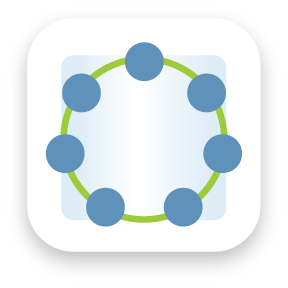
Engineering-Design Aligned Curricula

The TeachEngineering hands-on activities featured here, by grade band, exemplify the engineering design process.
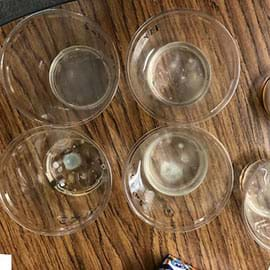
Students investigate what causes them to become sick during the school year. They use the engineering design process to test the classroom lab spaces for bacteria. After their tests, they develop ideas to control the spread of germs within the classroom.
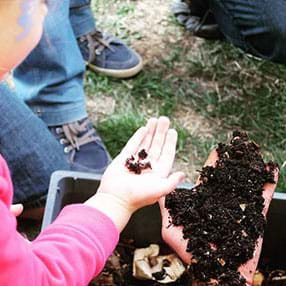
A unique activity for young learners that combines engineering and biology, students design an optimal environment for red wiggler worms in a compost bin.
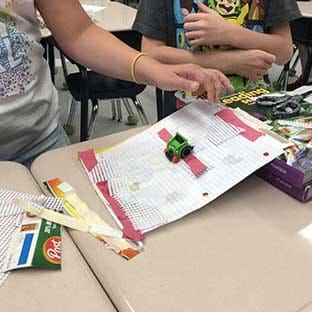
In this maker challenge, students use the engineering design process to design a covering for a portable wheelchair ramp for their school. The design must be easy to use, and allows people to move up the ramp easily and go down slowly.
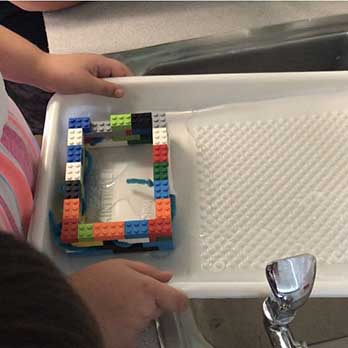
Students employ the engineering design process to create a device that uses water-absorbing crystals for use during a flood or storm surge. They use (or build) a toy house, follow the engineering design process to build their device, and subject the house to tests that mimic a heavy flood or rising ...
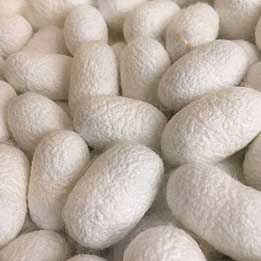
Students use the engineering design process to design a bridge out of silkworm cocoons that can hold at least 50 grams. Students can use other materials to supplement the silk bridge, but have a $10 budget.

In this multi-day activity, students explore environments, ecosystems, energy flow and organism interactions by creating a scale model biodome, following the steps of the engineering design process.

Build a model race car out of lifesaver candies, popsicle sticks, straws, and other fun materials! Have students learn about independent, dependent, and control variables, and find out who can make the fastest car given their new knowledge.

Design and construct a bridge for a local city that will have a high strength-to-weight ratio and resist collapse. Have students use their understanding of the engineering design process—and a lot of wooden craft sticks—to achieve their goals.

In this two-part activity, students design and build Rube Goldberg machines. This open-ended challenge employs the engineering design process and may have a pre-determined purpose, such as rolling a marble into a cup from a distance, or let students decide the purposes.

Students are challenged to design and build rockets from two-liter plastic soda bottles that travel as far and straight as possible or stay aloft as long as possible. Guided by the steps of the engineering design process, students first watch a video that shows rocket launch failures and then partic...

Students explore how mass affects momentum in head-on collisions and experience the engineering design process as if they are engineers working on the next big safety feature for passenger cars. They design, create and redesign impact-resistant passenger vehicle compartments for small-size model car...
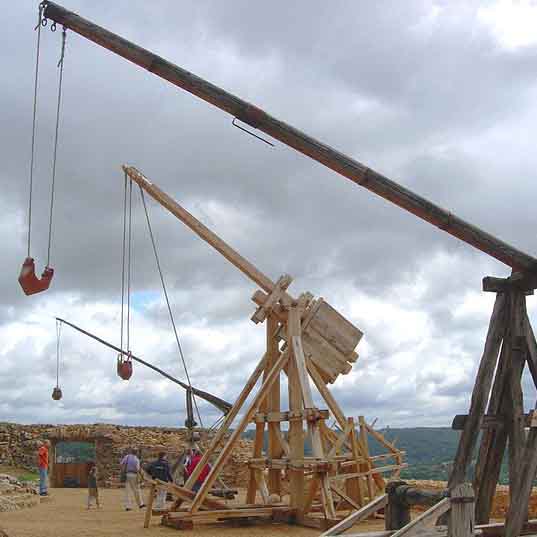
Students work as teams of engineers to design and build their own trebuchets. They research how to build and test their trebuchets, evaluate their results, and present their results and design process to the class.
Grades 9-12

Student teams follow the steps of the engineering design process as they design and build architecturally inspired cardboard furniture. Given a list of constraints, including limited fabrication materials and tools, groups research architectural styles, brainstorm ideas, make small-scale quick proto...

Students follow the steps of the engineering design process as they design and construct balloons for aerial surveillance. Applying their newfound knowledge, the young engineers build and test balloons that fly carrying small flip cameras that capture aerial images of their school.

Student teams design, build and test small-sized gliders to maximize flight distance and an aerodynamic ratio, applying their knowledge of fluid dynamics to its role in flight. Students experience the entire engineering design process, from brainstorming to CAD (or by hand) drafting, including resea...
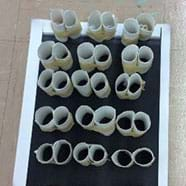
Students learn about human proteins, how their shapes are related to their functions and how DNA protein mutations result in diseases. Then, in a hypothetical engineering scenario, they use common classroom supplies to design and build their own structural, transport and defense protein models to he...

Students develop an app for an Android device that utilizes its built-in internal sensors, specifically the accelerometer. The goal of this activity is to teach programming design and skills using MIT's App Inventor software (free to download from the Internet) as the vehicle for learning.
Welcome to TeachEngineering’s Engineering Design Process curricula for Grade K-2 Educators!

Create popsicles using the engineering design process! In this activity, students work to solve the problems of a local popsicle shop while learning how scientific and engineering concepts play a part in behind-the-scenes design.
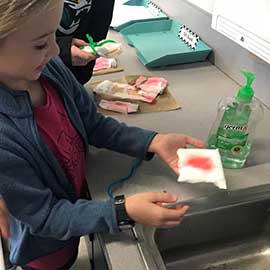
In this maker challenge, students follow the engineering design process and use water-absorbing crystals to create a bandage that can be used in a traumatic situation, like a car accident or hiking accident.
Maker Challenge

Students perform research and design prosthetic prototypes for an animal to use for its survival. They research a set of pre-chosen animals and their habitats. They then create habitats for their animals to live and model 3D prosthetics for the animals to use with modeling clay.

Given scrap cardboard, paper towel tubes, scissors, and glue, how could a student invent their own backscratcher? Engage in the process of how real engineers design products to meet a desired function.

Students design a way for mint plants to keep a constant moisture level for 72 hours. The mint plants must be kept moist since they are young and just starting to establish growth.

Design a customized table top supply organizer inspired by the natural home of a ladybug—or any other insect of a student's choosing—to hold all of their classroom supplies! By the end of this activity, students will understand the properties of biomimicry and the engineering design process.
Welcome to TeachEngineering’s Engineering Design Process curricula for Grade 3-5 Educators!

As students learn about the creation of biodomes, they are introduced to the steps of the engineering design process, including guidelines for brainstorming. They learn how engineers are involved in the design and construction of biodomes and use brainstorming to come up with ideas for possible biod...

Students learn about providing healthcare in a global setting and the importance of wearing protective equipment when treating patients with infectious diseases like Ebola. They learn about biohazard suits, heat transfer through conduction and convection and the engineering design cycle. Student tea...

Working as if they are engineers who work for (the hypothetical) Build-a-Toy Workshop company, students apply their imaginations and the engineering design process to design and build prototype toys with moving parts. They set up electric circuits using batteries, wire and motors. They create plans ...

Whether on Earth or in space, life-threatening illnesses may occur if the water we drink is of poor quality. It’s up to your students to design and build a filtration system for the International Space Station so they can guarantee astronauts get the safe and clean water they need.

Your students have been hired to build a pop rocket, but on a tight budget. Engineering design usually has some constraints and you won’t always have access to the materials you think you might need. But through brainstorming and trial and error, a viable rocket launch is definitely possible!

In this activity, students design and build model houses, then test them against various climate elements, and then re-design and improve them. Using books, websites and photos, students learn about the different types of roofs found on various houses in different environments throughout the world....

Students pretend they are agricultural engineers during the colonial period and design a miniature plow that cuts through a "field" of soil. They are introduced to the engineering design process and learn of several famous historical figures who contributed to plow design.

Students learn how to use wind energy to combat gravity and create lift by creating their own tetrahedral kites capable of flying. They explore different tetrahedron kite designs, learning that the geometry of the tetrahedron shape lends itself well to kites and wings because of its advantageous str...

Students learn the basics of engineering sneakers and shoes. They are challenged to decide on specific design requirements, such as heavy traction or extra cushioning, and then use different materials to create working prototype shoes that meet the design criteria. Includes worksheets.

For this maker challenge, students decide on specific design requirements (such as good traction or deep cushioning), sketch their plans, and then use a variety of materials to build prototype shoes that meet the design criteria.

Students design a temporary habitat for a future classroom pet—a hingeback tortoise. The students investigate hingeback tortoise habitat features as well as the design features of such a habitat. Each group communicates and presents this information to the rest of the class after they research, brai...

When a person gets injured in the wilderness and needs medical attention, rescuers might use a device called a mountain rescue litter specifically designed for difficult evacuations. Design and build a small-sized prototype to save some (potatoes’) lives!

Student teams are challenged to navigate a table tennis ball through a timed obstacle course using only the provided unconventional “tools.” Teams act as engineers by working through the steps of the engineering design process to complete the overall task with each group member responsible to accomp...

Students explore the engineering design process within the context of Dr. Seuss’s book, Bartholomew and the Oobleck. Students study a sample of aloe vera gel (the oobleck) in lab groups. After analyzing the substance, they use the engineering design process to develop and test other substances to ma...

Students explore the use of wind power in the design, construction and testing of "sail cars," which, in this case, are little wheeled carts with masts and sails that are powered by the moving air generated from a box fan. The scientific method is reviewed and reinforced with the use of controls and...

Students engage in the second design challenge of the unit, which is an extension of the maze challenge they solved in the first lesson/activity of this unit. Students extend the ideas learned in the maze challenge with a focus more on the robot design. Specifically, students learn how to design the...

Student groups are challenged to program robots with color sensors to follow a black line. Learning both the logic and skills behind programming robots for this challenge helps students improve their understanding of how robots "think" and widens their appreciation for the complexity involved in pro...

As part of a design challenge, students learn how to use a rotation sensor (located inside the casing of a LEGO® MINDSTORMS ® EV3 motor) to measure how far a robot moves with each rotation. Through experimentation and measurement with the sensor, student pairs determine the relationship between the ...

As the first engineering design challenge of the unit, students are introduced to the logic for solving a maze. Student groups apply logic to program LEGO® MINDSTORMS® EV3 robots to navigate through a maze, first with no sensors, and then with sensors.

Student pairs experience the iterative engineering design process as they design, build, test and improve catching devices to prevent a "naked" egg from breaking when dropped from increasing heights. To support their design work, they learn about materials properties, energy types and conservation o...

Students apply what they have learned about the engineering design process to a real-life problem that affects them and/or their school. They choose a problem as a group, and then follow the engineering design process to come up with and test their design solution.

Working individually or in pairs, students compete to design, create, test and redesign free-standing, weight-bearing towers using Kapla® wooden blocks. The challenge is to build the tallest tower while meeting the design criteria and minimizing the amount of material used—all within a time limit.

Students experience the engineering design process as they design and build accurate and precise catapults using common materials. They use their catapults to participate in a game in which they launch Ping-Pong balls to attempt to hit various targets.
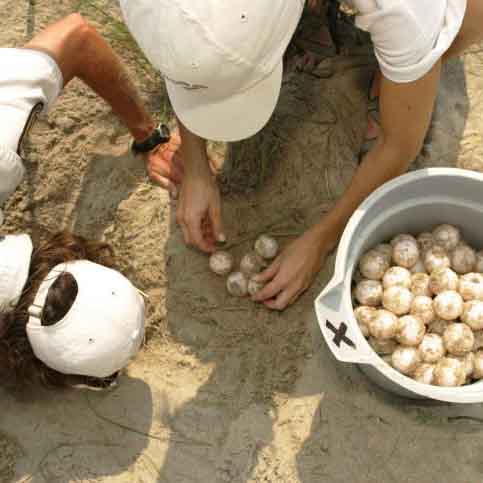
Students employ the full engineering design process to research and design prototypes that could be used to solve the loss of sea turtle life during a hurricane. Students learn about sea turtle nesting behaviors and environmental impacts of hurricanes. Students work collaboratively to build structur...

Students learn how engineering design is applied to solve healthcare problems by using an engineering tool called simulation. While engineering design is commonly used to study and design everything from bridges, factories, airports to space shuttles, the use of engineering design to study healthcar...

Students learn about civil engineers and work through each step of the engineering design process in two mini-activities that prepare them for a culminating challenge to design and build the tallest straw tower possible, given limited time and resources. In the culminating challenge (tallest straw t...

Students apply their knowledge of constructing and programming LEGO® MINDSTORMS® robots to create sumobots—strong robots capable of pushing other robots out of a ring. To meet the challenge, groups follow the steps of the engineering design process and consider robot structure, weight and gear ratio...

Students learn about health risks caused by cooking and heating with inefficient stoves inside homes. They simulate the cook stove scenario and follow the engineering design process steps, including iterative trials, to increase warmth inside a building while reducing air quality problems. A student...

Students work together in small groups, while competing with other teams, to explore the engineering design process through a tower building challenge. They are given a set of design constraints and then conduct online research to learn basic tower-building concepts. During a two-day process and usi...

Students are introduced to the engineering design process, focusing on the concept of brainstorming design alternatives. They learn that engineering is about designing creative ways to improve existing artifacts, technologies or processes, or developing new inventions that benefit society.

Students' understanding of how robotic ultrasonic sensors work is reinforced in a design challenge involving LEGO® MINDSTORMS® EV3 robots and ultrasonic sensors. Student groups program their robots to move freely without bumping into obstacles (toy LEGO people).

Student pairs design and construct small, wind-powered sail cars using limited quantities of drinking straws, masking tape, paper and beads. Teams compete to see which sail car travels the farthest when pushed by the wind (simulated by the use of an electric fan). Students learn about wind and kinet...
Welcome to TeachEngineering’s Engineering Design Process curricula for Grade 6-8 Educators!

Student teams are challenged to design assistive devices that modify crutches to help people carry things such as books and school supplies. Given a list of constraints, including a device weight limit and minimum load capacity, groups brainstorm ideas and then make detailed plans for their best sol...

Students gain experience with the software/system design process, closely related to the engineering design process, to solve a problem. The lesson culminates in a hands-on experience with the design process as students simulate the remote control of a rover.

Students design, build and test looping model roller coasters using foam pipe insulation tubing. They learn about potential and kinetic energy as they test and evaluate designs, addressing the task as if they are engineers. Winning designs have the lowest cost and best aesthetics. Three student work...

Students design and develop a useful assistive device for people challenged by fine motor skill development who cannot grasp and control objects. In the process of designing prototype devices, they learn about the engineering design process and how to use it to solve problems.

Students learn more about assistive devices, specifically biomedical engineering applied to computer engineering concepts, with an engineering challenge to create an automatic floor cleaner computer program. Following the steps of the design process, they design computer programs and test them by pr...

Students groups use balsa wood and glue to build their own towers using some of the techniques they learned from the associated lesson.

Student teams are challenged to design models of Egyptian funerary barges for the purpose of transporting mummies through the underworld to the afterlife. Students design and build prototypes using materials and tools like the ancient Egyptians had at their disposal.
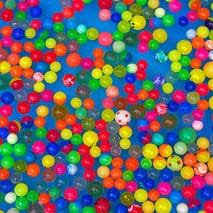
Students become product engineers in a bouncy ball factory as they design and prototype a polymer bouncy ball that meets specific requirements: must be spherical in shape, cannot disintegrate when thrown on the ground, and must bounce.

Students are introduced to the concept and steps of the engineering design process and taught how to apply it. In small groups, students learn of their design challenge (improve a cast for a broken arm), brainstorm solutions, are given materials and create prototypes.

Students become familiar with the engineering design process as they design, build, and test chair prototypes.

In this activity, students undertake a similar engineering challenge as they design and build a filter to remove pepper from an air stream without blocking more than 50% of the air.

Following the steps of the engineering design process and acting as biomedical engineers, student teams use everyday materials to design and develop devices and approaches to unclog blood vessels. Through this open-ended design project, they learn about the circulatory system, biomedical engineering...

Students design and build small doghouses to shelter a (toy) puppy from the heat—and create them within constraints. They apply what they know about light energy and how it travels through various materials, as well as how a material’s color affects its light absorption and reflection. They test the...
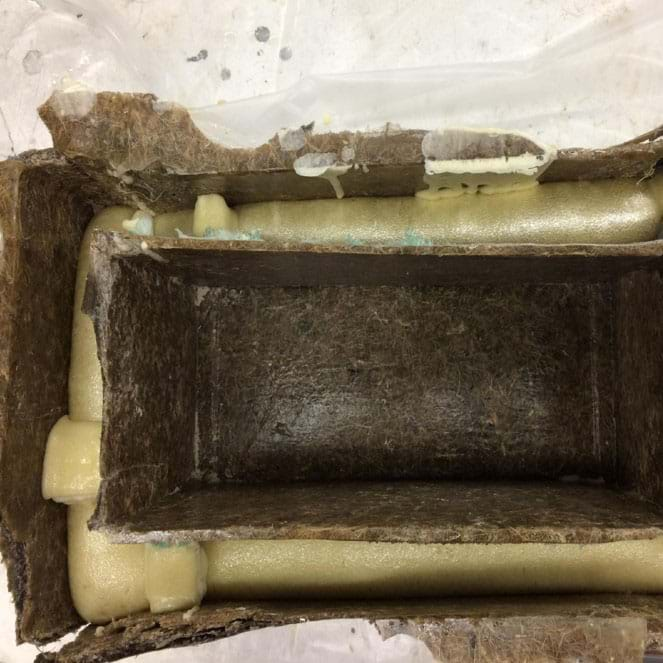
Students learn about convection, conduction, and radiation in order to solve the challenge of designing and building a small insulated cooler with the goal of keeping an ice cube and a Popsicle from melting. This activity uses the engineering design process to build the cooler as well as to measure ...

Students are given a biomedical engineering challenge, which they solve while following the steps of the engineering design process. In a design lab environment, student groups design, create and test prototype devices that help people using crutches carry things, such as books and school supplies.
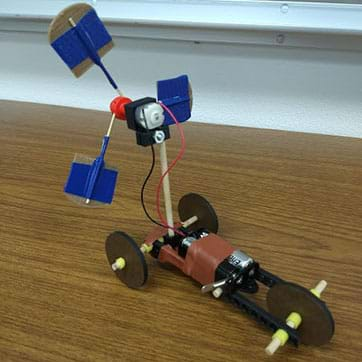
Students build an electric racer vehicle using Tinkercad to design blades for their racers. Students print their designs using a MakerBot printer. Students race their vehicles to see which design travels the furthest distance in the least amount of time.
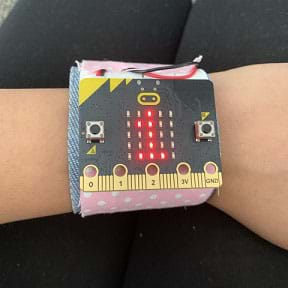
Students use the engineering design process to design, create, and test a pedometer that keeps track of the number of steps a person takes. This maker challenge exposes students to basic coding, micro:bit processor applications, and how programming and engineering can be used to solve health problem...
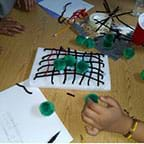
Students learn how to engineer a design for a polymer brush—a coating consisting of polymers that represents an antifouling polymer brush coating for a water filtration surface.

Students program the drive motors of a SparkFun RedBot with a multistep control sequence—a “dance.” Doing this is a great introduction to robotics and improves overall technical literacy by helping students understand that we use programs to control the motion and function of robots, and without the...

Students gain an understanding of the factors that affect wind turbine operation. Following the steps of the engineering design process, engineering teams use simple materials (cardboard and wooden dowels) to build and test their own turbine blade prototypes with the objective of maximizing electric...

Students further their understanding of the engineering design process (EDP) while applying researched information on transportation technology, materials science and bioengineering. Students are given a fictional client statement (engineering challenge) and directed to follow the steps of the EDP t...

Students learn about the process of reverse engineering and how this technique is used to improve upon technology. Students analyze push-toys and draw diagrams of the predicted mechanisms inside the toys. Then, they disassemble the toys and draw the actual inner mechanisms.
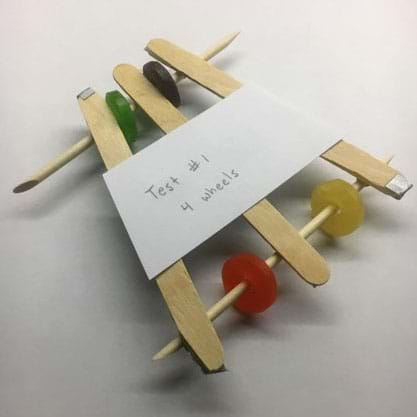
Students design, build, and test model race cars made from simple materials (lifesaver-shaped candies, plastic drinking straws, Popsicle sticks, index cards, tape) as a way to explore independent, dependent and control variables.

Students use the engineering design process to solve a real-world problem—shoe engineering! Working in small teams, they design, build and test a pair of wearable platform or high-heeled shoes, taking into consideration the stress and strain forces that it will encounter from the shoe wearer.

Students' understanding of how robotic color sensors work is reinforced in a design challenge involving LEGO® MINDSTORMS® robots and light sensors. Working in pairs, students program LEGO robots to follow a flashlight as its light beam moves around.

Students further their understanding of the engineering design process while combining mechanical engineering and bioengineering to create an automated medical device.

Students apply the concepts of conduction, convection and radiation as they work in teams to solve two challenges. One problem requires that they maintain the warm temperature of one soda can filled with water at approximately human body temperature, and the other problem is to cause an identical so...

Students design and build a mechanical arm that lifts and moves an empty 12-ounce soda can using hydraulics for power. Small design teams (1-2 students each) design and build a single axis for use in the completed mechanical arm.

Using ordinary classroom materials, students act as biomedical engineering teams challenged to design prototype models that demonstrate semipermeability to help medical students learn about kidney dialysis. A model consists of two layers of a medium separated by material acting as the membrane. Grou...
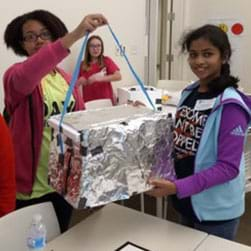
Students brainstorm, design, and build a cooler and monitor its effectiveness to keep a bottle of ice water cold in comparison to a bottle of ice water left at room temperature. Students engage in design by choosing from a range of materials to build their prototype.

Students learn about how biomedical engineers create assistive devices for persons with fine motor skill disabilities. They do this by designing, building and testing their own hand "gripper" prototypes that are able to grasp and lift a 200 ml cup of sand.

Based on their experience exploring the Mars rover Curiosity and learning about what engineers must go through to develop a vehicle like Curiosity, students create Android apps that can control LEGO® MINDSTORMS® robots, simulating the difficulties the Curiosity rover could encounter. The activity go...

Acting as biomedical engineers, students design, build, test and redesign prototype heart valves using materials such as waterproof tape, plastic tubing, flexible plastic and foam sheets, clay, wire and pipe cleaners. They test them with flowing water, representing blood moving through the heart.

Students further their understanding of the engineering design process (EDP) while being introduced to assistive technology devices and biomedical engineering. They are given a fictional client statement and are tasked to follow the steps of the EDP to design and build small-scale, off-road wheelcha...
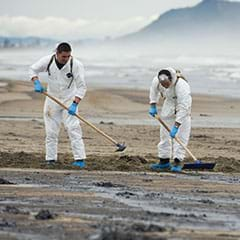
Student groups create and test oil spill cleanup kits that are inexpensive and accessible for homeowners or for big companies to give to individual workers—to aid in home, community or environmental oil spill cleanup process.

Using paper, paper clips and tape, student teams design flying/falling devices to stay in the air as long as possible and land as close as possible to a given target. Student teams use the steps of the engineering design process to guide them through the initial conception, evaluation, testing and r...

Students learn how biomedical engineers work with engineers and other professionals to develop dependable medical devices. Student teams brainstorm, sketch, design and create prototypes of suction pump protection devices to keep fluid from backing up and ruining the pump motors.

Students experience the steps of the engineering design process as they design solutions for a real-world problem that negatively affects the environment. They use plastic tubing and assorted materials such as activated carbon, cotton balls, felt and cloth to create filters with the capability to re...

Students design and create sensory integration toys for young children with developmental disabilities—an engineering challenge that combines the topics of biomedical engineering, engineering design and human senses. Students learn the steps of the engineering design process (EDP) and how to use it ...
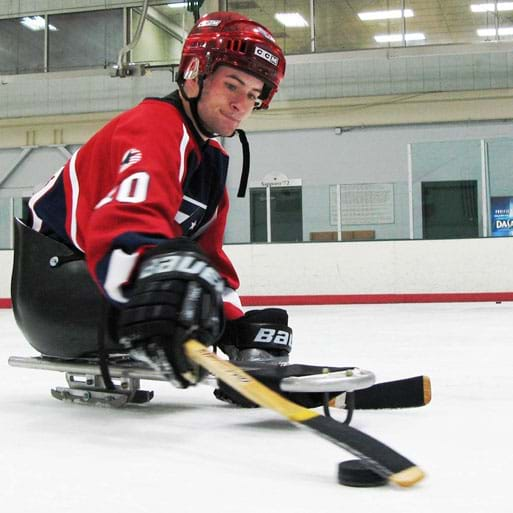
Students are asked to design a hockey stick for a school’s new sled hockey team. Using the engineering design process, students act as material engineers to create hockey sticks that have different interior structures using multiple materials that can withstand flexure testing.

Working as if they were engineers, students design and construct model solar sails made of aluminum foil to move cardboard tube satellites through “space” on a string. Working in teams, they follow the engineering design thinking steps—ask, research, imagine, plan, create, test, improve—to design an...

Students follow the steps of the engineering design process to create their own ear trumpet devices (used before modern-day hearing aids), including testing them with a set of reproducible sounds.

Student pairs design, build, and test model vehicles capable of rolling down a ramp and then coasting freely as far as possible. The challenge is to make the vehicles entirely out of dry pasta using only adhesive (such as hot glue) to hold the components together.

Students are challenged to design, build and test small-scale launchers while they learn and follow the steps of the engineering design process. For the challenge, the "slingers" must be able to aim and launch Ping-Pong balls 20 feet into a goal using ordinary building materials such as tape, string...
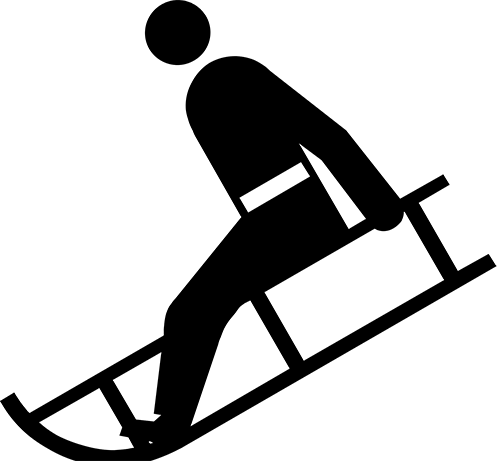
Students act as engineers to solve a hypothetical problem that has occurred in the Swiss Alps due to a natural seismic disaster. Working in groups, they follow the engineering design process steps to create model sleds that meet the requirements to transport materials to people in distress that live...

Students learn more about how muscles work and how biomedical engineers can help keep the muscular system healthy. Following the engineering design process, they create their own biomedical device to aid in the recovery of a strained bicep.

In this activity, student groups design and build three types of towers (guyed or cable-supported, free-standing or self-standing, and monopole), engineering them to meet the requirements that they hold an egg one foot high for 15 seconds.
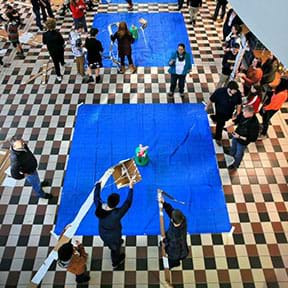
A classic engineering challenge involves designing and building devices that can deliver necessary goods to “Toxic Island.” Working within specific constraints, students design a device that must not touch the water or island, and must deliver supplies accurately and quickly.

Students are given a difficult challenge that requires they integrate what they have learned so far in the unit about wait blocks, loops and switches. They incorporate these tools into their programming of the LEGO® MINDSTORMS® robots to perform different tasks depending on input from a sound sensor...

Students apply their knowledge of scale and geometry to design wearables that would help people in their daily lives, perhaps for medical reasons or convenience. Like engineers, student teams follow the steps of the design process, to research the wearable technology field (watching online videos an...

Students reinforce an antenna tower made from foam insulation so that it can withstand a 480 N-cm bending moment (torque) and a 280 N-cm twisting moment (torque) with minimal deflection.

Students further their understanding of the engineering design process while combining mechanical engineering and bio-engineering to create assistive devices. During this extended activity (seven class periods), students are given a fictional client statement and required to follow the steps of the ...
Welcome to TeachEngineering’s Engineering Design Process curricula for Grade 9-12 Educators!

Students experience the engineering design process as they design and construct lower-leg prostheses in response to a hypothetical zombie apocalypse scenario. Building on what they learned and researched in the associated lesson, they design and fabricate a replacement prosthetic limb using given sp...

In this culminating activity, student groups act as engineering design teams to derive equations to determine the stability of specific above-ground storage tank scenarios with given tank specifications and liquid contents. With their flotation analyses completed and the stability determined, studen...

Students apply the design process to the problem of hiding a message in a digital image using steganographic methods, a PictureEdit Java class, and API (provided as an attachment). They identify the problems and limitations associated with this task, brainstorm solutions, select a solution, and impl...
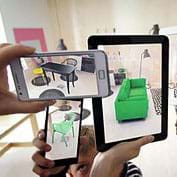
Students explore augmented reality programs, including muscle and bone overlays and body tracking recording program, using Unity and Microsoft Visual Studio and develop ways to modify, enhance, and redesign the program to meet a particular real-world need.

Student teams design their own booms (bridges) and engage in a friendly competition with other teams to test their designs. Each team strives to design a boom that is light, can hold a certain amount of weight, and is affordable to build.

Students use Arduino microcontrollers and light-sensitive resistors (photocells) to sense the ambient light levels in a room and turn LEDs on and off based on those readings. They are challenged to personalize their basic night-lights with the use of more LEDs, if/else statements and voltage divider...

Students gain practice in Arduino fundamentals as they design their own small-sized prototype light sculptures to light up a hypothetical courtyard. They program Arduino microcontrollers to control the lighting behavior of at least three light-emitting diodes (LEDs) to create imaginative light displ...
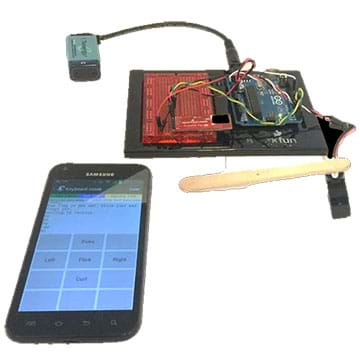
Students learn how to control an Arduino servo wirelessly using a simple phone application, Bluetooth module and an Android phone. This prepares them to wirelessly control their own projects.

Student teams design and build shoe prototypes that convert between high heels and athletic shoes. They apply their knowledge about the mechanics of walking and running as well as shoe design (as learned in the associated lesson) to design a multifunctional shoe that is both fashionable and function...

Students use servos and flex sensors to make simple, one-jointed, finger robots. They use Arduino microcontrollers, create circuits and write code to read finger flexes and send angle info to servos. They explore the constrain, map and smoothing commands. Can teams combine fingers to create an entir...
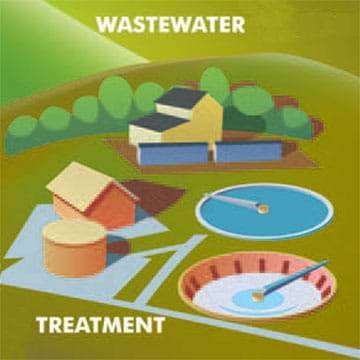
Student teams design, construct, test and improve small working models of water treatment plant processes to filter out contaminants and reclaim resources from simulated wastewater. They keep to a materials budget and earn money from reclaimed materials. They conduct before/after water quality tests...

Students are introduced to the biomechanical characteristics of helmets, and are challenged to incorporate them into designs for helmets used for various applications.
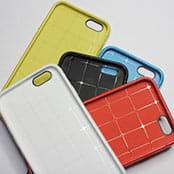
Students design and create their own nano-polymer smartphone case. Students choose their design, mix their nano-polymer (based in silicone) with starch and add coloring of their choice. While students think critically about their design, they embed strings in the nano-polymer material to optimize bo...

Student teams create laparoscopic surgical robots designed to reduce the invasiveness of diagnosing endometriosis and investigate how the disease forms and spreads. Using a synthetic abdominal cavity simulator, students test and iterate their remotely controlled, camera-toting prototype devices, whi...

Students learn about the mathematical characteristics and reflective property of ellipses by building their own elliptical-shaped pool tables. After a slide presentation introduction to ellipses, student “engineering teams” follow the steps of the engineering design process to develop prototypes, wh...

Following the steps of the iterative engineering design process, student teams use what they learned in the previous lessons and activity in this unit to research and choose materials for their model heart valves and test those materials to compare their properties to known properties of real heart ...

Students design, build and test small-sized vehicle prototypes that transfer various types of potential energy into motion. To complete the Go Public phase of the legacy cycle, students demonstrate their understanding of how potential energy may be transferred into kinetic energy.

Students explore how to modify surfaces such as wood or cotton fabric at the nanoscale. They create specialized materials with features such as waterproofing and stain resistance. The challenge starts with student teams identifying an intended user and developing scenarios for using their developed ...

Students apply their understanding of light polarization and attenuation to design, fabricate, test and refine their own prototype sunglasses that better reduce glare and lower light intensity compared to available sunglasses, and better protect eyes from UVA and UVB radiation. They meet the project...
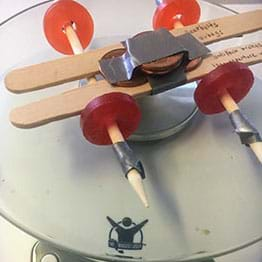
High school students design, build, and test model race cars made from simple materials (lifesaver-shaped candies, plastic drinking straws, Popsicle sticks, index cards, tape) as a way to explore independent, dependent and control variables.

During this engineering design/build project, students investigate many different solutions to a problem. Their design challenge is to find a way to get school t-shirts up into the stands during home sporting events. They follow the steps of the engineering design process to design and build a usabl...
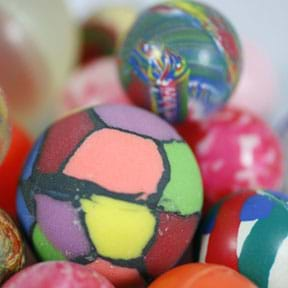
Students work as materials and chemical engineers to develop a bouncy ball using a select number of materials. They develop a plan of what materials they might need to design their product, and then create, test, and evaluate their bouncy ball.

Student pairs design, redesign and perform simple experiments to test the differences in thermal conductivity (heat flow) through different media (foil and thin steel). Then students create visual diagrams of their findings that can be understood by anyone with little background on the subject, appl...

Students follow the steps of the engineering design process to design an improved smartphone case. As if they are materials engineers, they evaluate how to build a smartphone case and study physical properties, chemical properties, and tessellations. They analyze materials, design and improve a prot...

Students learn how to connect Arduino microcontroller boards to computers and write basic code to blink LEDs. Provided steps guide students through the connection process, troubleshooting common pitfalls and writing their first Arduino programs. Then they independently write their own code to blink ...
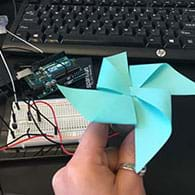
Students control small electric motors using Arduino microcontrollers to make little spinning fans made with folded and glued paper sticky notes. They build basic circuits and modify code, before applying the principles to create their own more-complicated motor-controlled projects. Advanced project...

Students create a water bottle from common materials used in purification tools that can clean dirty water as an inexpensive alternative to a modern filter. Students may iterate upon their design based off their experiment and the designs of their classmates after initial testing.
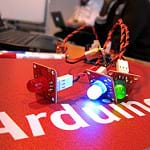
Students take on the challenge of assembling a light sensor circuit in order to observe its readings using the Arduino Serial Monitor. They also create their own unique visualization through software called Processing. They learn how to use calibration and smoothing along the way to capture a better...

Students investigate Python and Jupyter Notebook to analyze real astronomical images in order to calculate the interstellar distance to a star cluster across the Milky Way from our own Solar System. They learn how to write Python code that runs in a Jupyter Notebook so they can determine the brightn...

Students design, build and evaluate a spring-powered mouse trap racer. For evaluation, teams equip their racers with an intelligent brick from a LEGO© MINDSTORMS© EV3 Education Core Set and a HiTechnic© acceleration sensor.

Students apply their knowledge of linear regression and design to solve a real-world challenge to create a better packing solution for shipping cell phones. They make composite material packaging containers using cardboard, fabric, plastic, paper and/or rubber bands to create four different-weight p...

Students learn how engineers harness the energy of the wind to produce power by following the engineering design process as they prototype two types of wind turbines and test to see which works best. Students also learn how engineers decide where to place wind turbines, and the advantages and disadv...

Students experience the engineering design process as they design, fabricate, test and redesign their own methods for encapsulation of a (hypothetical) new miracle drug. The objective is to delay the drug release by a certain time and have a long release duration—patterned after the timed release re...

In this hands-on activity, student groups design, build, test and improve devices to pump water as if they were engineers helping a rural village meet their drinking water supply. Students keep track of their materials costs, and calculate power and cost efficiencies of the prototype pumps.

Students practice human-centered design by imagining, designing and prototyping a product to improve classroom accessibility for the visually impaired. Student teams follow the steps of the engineering design process to formulate their ideas, draw them by hand and using free, online Tinkercad softwa...

Students write Arduino code and use a “digital sandbox” to create new colors out of the three programming primary colors: green, red and blue. They develop their own functions, use them to make disco light shows, and vary the pattern and colors of their shows.

Student teams each design, build and test a composite material for use as a concrete building block for shantytown use. The design challenge constraints include: using inexpensive and readily available materials, chemically resistant, physically durable, cost-effective and aesthetically pleasing. Th...
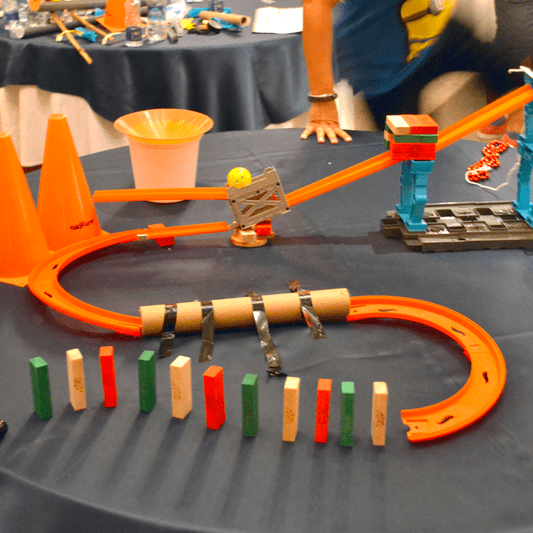
Students research and learn about simple machines and other mechanisms through learning about a Rube Goldberg machine. Student teams design and build their own Rube Goldberg devices that incorporate at least six simple machines. This project is open-ended with much potential for creativity and fun.

Students explore energy efficiency, focusing on renewable energy, by designing and building flat-plate solar water heaters. They calculate the efficiency of the solar water heaters during initial and final tests and compare the efficiencies to those of models currently sold on the market (requiring ...

Refreshed with an understanding of the six simple machines; screw, wedge, pully, incline plane, wheel and axle, and lever, student groups receive materials and an allotted amount of time to act as mechanical engineers to design and create machines that can complete specified tasks.
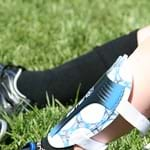
Students engineer a working pair of shin guards for soccer or similar contact sport from everyday materials. Since many factors go into the design of a shin guard, students follow the engineering design process to create a prototype.

Students work through an online tutorial on MIT's App Inventor to learn how to create Android applications. Using those skills, they create their own applications and use them to collect data from an Android device accelerometer and store that data to databases.
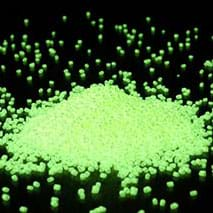
Students learn about the engineering design process and how products may be reinvented to serve new purposes. Working in groups, students design a type of slime. After creating their slime, the teacher turns out the lights and the students see that the slime they made actually glows in the dark!

Students are challenged to design and program Arduino-controlled robots that behave like simple versions of the automated guided vehicles engineers design for real-world applications. Using Arduino microcontroller boards, infrared (IR) sensors, servomotors, attachable wheels and plastic containers (...

Students imagine they are stranded on an island and must create the brightest light possible with the meager supplies they have on hand in order to gain the attention of a rescue airplane. In small groups, students create circuits using items in their "survival kits" to create maximum voltage, measu...

Students work within constraints to construct model trusses and then test them to failure as a way to evaluate the relative strength of different truss configurations and construction styles. Within each group, each student builds two exact copies of the team's truss configuration using his/her own ...

Students are challenged to find a way to get school t-shirts up into the stands during sporting events. They work with a real client (if possible, such as a cheerleading squad, booster club or band) to determine the requirements and constraints that would make the project a success, including a budg...
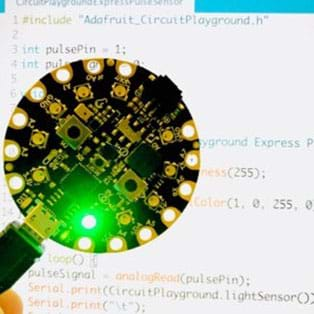
Biomedical engineers design, create, and test health technology that measure all sorts of physical functions in the body, including heartbeat. Students play the role of biomedical engineers in this activity and create a device that helps visualize heartbeats.
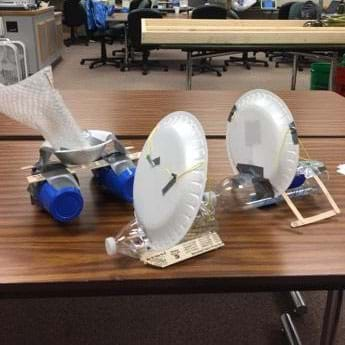
Students use a variety of common office and household supplies to design a boat. Their goal: to not only design the fastest boat, but also take into account how much mass or “cargo” the boat can carry, the stability of the boat in the water, the total mass of the boat, boat aesthetics, and how much ...

Students are challenged to design and build wind chimes using their knowledge of physics and sound waves, and under given constraints such as weight, cost and number of musical notes it must generate.
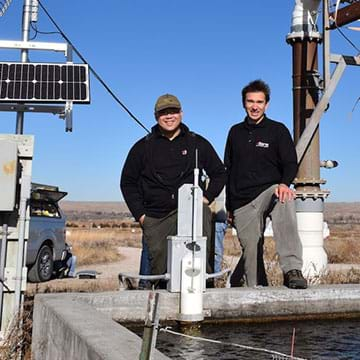
Students learn how to send signals (such as from buttons or sensors) from one system to another using XBee radio communication modules. By activity end, they are able to control LEDs and motors wirelessly using Arduino microcontrollers and XBee shields. Introduces the concept of the Internet of thin...


Tips for Solving Engineering Problems Effectively
Problem solving is the process of determining the best feasible action to take in a given situation. Problem solving is an essential skill for engineers to have. Engineers are problem solvers, as the popular quote says:
“Engineers like to solve problems. If there are no problems handily available, they will create their own problems.” – Scott Adams
Engineers are faced with a range of problems in their everyday life. The nature of problems that engineers must solve differs between and among the various disciplines of engineering. Because of the diversity of problems there is no universal list of procedures that will fit every engineering problem. Engineers use various approaches while solving problems.
Engineering problems must be approached systematically, applying an algorithm, or step-by-step practice by which one arrives at a feasible solution. In this post, we’ve prepared a list of tips for solving engineering problems effectively.
#1 Identify the Problem

Evaluating the needs or identifying the problem is a key step in finding a solution for engineering problems. Recognize and describe the problem accurately by exploring it thoroughly. Define what question is to be answered and what outputs or results are to be produced. Also determine the available data and information about the problem in hand.
An improper definition of the problem will cause the engineer to waste time, lengthen the problem solving process and finally arrive at an incorrect solution. It is essential that the stated needs be real needs.
As an engineer, you should also be careful not to make the problem pointlessly bound. Placing too many limitations on the problem may make the solution extremely complex and tough or impossible to solve. To put it simply, eliminate the unnecessary details and only keep relevant details and the root problem.
#2 Collect Relevant Information and Data

After defining the problem, an engineer begins to collect all the relevant information and data needed to solve the problem. The collected data could be physical measurements, maps, outcomes of laboratory experiments, patents, results of conducted surveys, or any number of other types of information. Verify the accuracy of the collected data and information.
As an engineer, you should always try to build on what has already been done before. Don’t reinvent the wheel. Information on related problems that have been solved or unsolved earlier, may help engineers find the optimal solution for a given problem.
#3 Search for Creative Solutions
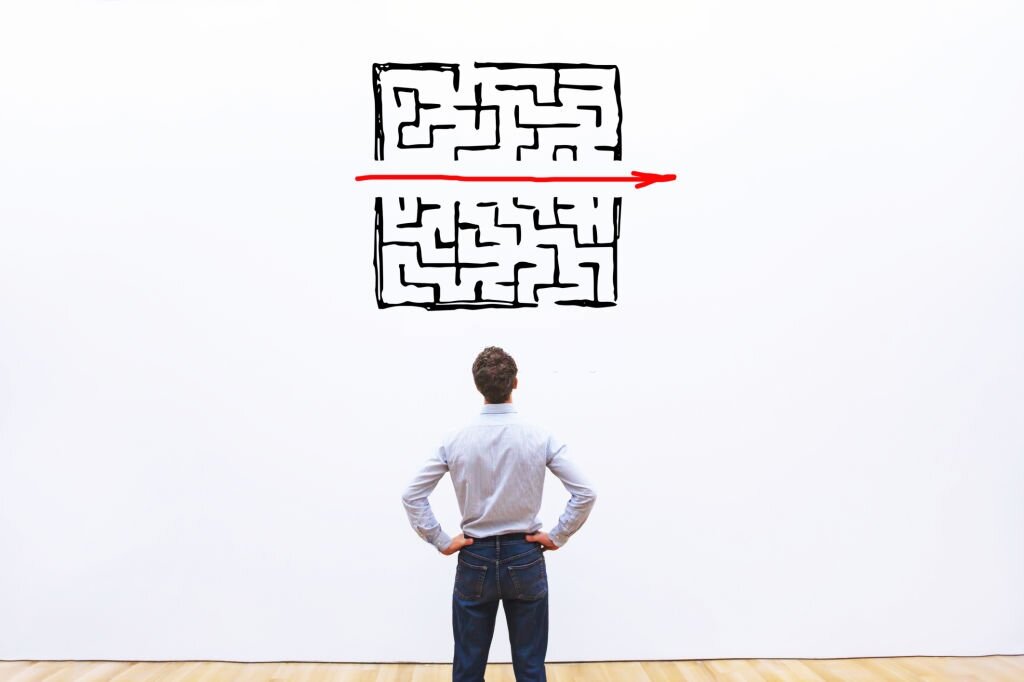
There are a number of methods to help a group or individual to produce original creative ideas. The development of these new ideas may come from creativity, a subconscious effort, or innovation, a conscious effort.
You can try to visualize the problem or make a conceptual model for the given problem. So think of visualizing the given problem and see if that can help you gain more knowledge about the problem.
#4 Develop a Mathematical Model

Mathematical modeling is the art of translating problems from an application area into tractable mathematical formulations whose theoretical and numerical analysis provides insight, answers, and guidance useful for the originating application.
To develop a mathematical model for the problem, determine what basic principles are applicable and then draw sketches or block diagrams to better understand the problem. Then define and introduce the necessary variables so that the problem is stated purely in mathematical terms.
Afterwards, simplify the problem so that you can obtain the required result. Also identify the and justify the assumptions and constraints in the mathematical model.
#5 Use Computational Method

You can use a computational method based on the mathematical method you’ve developed for the problem. Derive a set of equations that enable the calculation of the desired parameters and variables as described in your mathematical model. You can also develop an algorithm, or step-by-step procedure of evaluating the equations involved in the solution.
To do so, describe the algorithm in mathematical terms and then execute it as a computer program.
#6 Repeat the Problem Solving Process

Not every problem solving is immediately successful. Problems aren’t always solved appropriately the first time. You’ve to rethink and repeat the problem solving process or choose an alternative solution or approach to solving the problem.
Bottom-line:
Engineers often use the reverse-engineering method to solve problems. For example, by taking things apart to identify a problem, finding a solution and then putting the object back together again. Engineers are creative , they know how things work, and so they constantly analyze things and discover how they work.
Problem-solving skills help you to resolve obstacles in a situation. As stated earlier, problem solving is a skill that an engineer must have and fortunately it’s a skill that can be learned. This skill gives engineers a mechanism for identifying things, figuring out why they are broken and determining a course of action to fix them.
Subscribe Now!
Get our latest news, eBooks, tutorials, and free courses straight into your inbox.

Types of Engineers and What they Do [Explained]
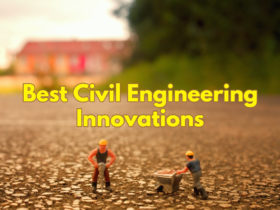
Latest innovations in civil engineering and construction industry

Civil Engineering: The Hardest Engineering Degree?
- Education & Career 34
- Industry 24
- Technology 18
GET OUR APP

Engineering Resources
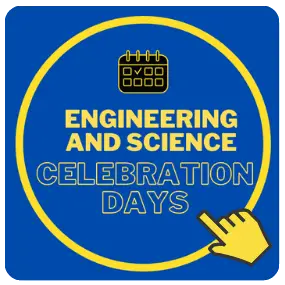
Everything you need to know about National Space Day
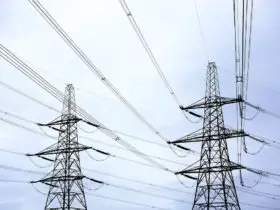
Is Electrical Engineering Hard? Here’s What You Need to Know


How it works
For Business
Join Mind Tools
Article • 8 min read
A Powerful Methodology for Creative Problem Solving
By the Mind Tools Content Team
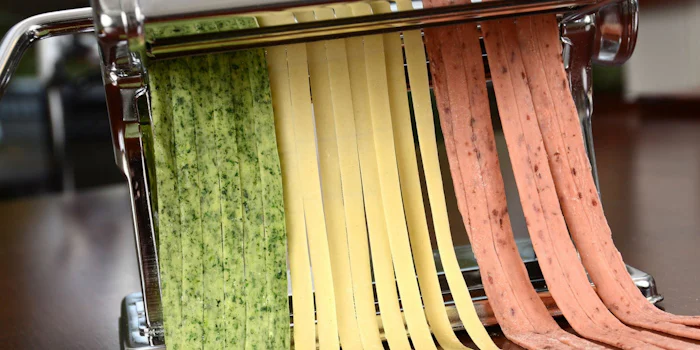
Projects don't always run smoothly. Even with all the analysis and data you need at your fingertips, sometimes you just can't see a way forward. At times like these, you need to develop creative solutions to the problems you face.
Chances are you already know about brainstorming , which can help with this sort of situation. But brainstorming depends on intuition and the existing knowledge of team members, and its results are often unpredictable and unrepeatable.
TRIZ, however, is a problem-solving philosophy based on logic, data and research, rather than on intuition.
It draws on the past knowledge and ingenuity of thousands of engineers to speed up creative problem solving for project teams. Its approach brings repeatability, predictability and reliability to the problem-solving process and delivers a set of dependable tools.
This article walks you through the essentials of TRIZ.
What is TRIZ?
TRIZ is the Russian acronym for the "Theory of Inventive Problem Solving," an international system of creativity developed in the U.S.S.R. between 1946 and 1985, by engineer and scientist Genrich S. Altshuller and his colleagues.
According to TRIZ, universal principles of creativity form the basis of innovation. TRIZ identifies and codifies these principles, and uses them to make the creative process more predictable.
In other words, whatever problem you're facing, somebody, somewhere, has already solved it (or one very like it). Creative problem solving involves finding that solution and adapting it to your problem.
TRIZ is most useful in roles such as product development, design engineering, and process management. For example, Six Sigma quality improvement processes often make use of TRIZ.
The Key TRIZ Tools
Let's look at two of the central concepts behind TRIZ: generalizing problems and solutions, and eliminating contradictions.
1. Generalizing Problems and Solutions
The primary findings of TRIZ research are as follows:
- Problems and solutions are repeated across industries and sciences. By representing a problem as a "contradiction" (we explore this later in this article), you can predict creative solutions to that problem.
- Patterns of technical evolution tend to repeat themselves across industries and sciences.
- Creative innovations often use scientific effects outside the field where they were developed.
Using TRIZ consists of learning these repeating patterns of problem and solution, understanding the contradictions present in a situation, and developing new methods of using scientific effects.
You then apply the general TRIZ patterns to the specific situation that confronts you, and discover a generalized version of the problem.
Figure 1, below, illustrates this process.
Figure 1 – The TRIZ Problem-Solving Method
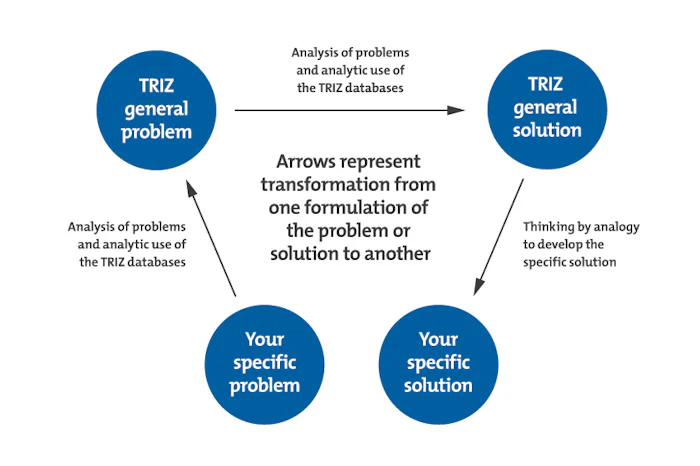
Here, you take the specific problem that you face and generalize it to one of the TRIZ general problems. From the TRIZ general problems, you identify the general TRIZ solution you need, and then consider how you can apply it to your specific problem.
The TRIZ databases are actually a collection of "open source" resources compiled by users and aficionados of the system (such as the 40 Principles and 76 Standard Solutions, which we look at, below).
2. Eliminating Contradictions
Another fundamental TRIZ concept is that there are fundamental contradictions at the root of most problems. In many cases, a reliable way to solve a problem is to eliminate these contradictions.
TRIZ recognizes two categories of contradictions:
- The product gets stronger (good), but the weight increases (bad).
- Service is customized to each customer (good), but the service delivery system gets complicated (bad).
- Training is comprehensive (good), but it keeps employees away from their assignments (bad).
The key technical contradictions are summarized in the TRIZ Contradiction Matrix . As with all TRIZ resources, it takes time and study to become familiar with the Contradiction Matrix.
- Software should be complex (to have many features), but simple (to be easy to learn).
- Coffee should be hot (to be enjoyed), but cool (to avoid burning the drinker).
- An umbrella should be large (to keep the rain off), but small (to be maneuverable in a crowd).
You can solve physical contradictions with the TRIZ Separation Principles . These separate your requirements according to basic categories of Space, Time and Scale.
How to Use TRIZ Principles – an Example
Begin to explore TRIZ by applying it to a simple, practical problem.
For example, consider the specific problem of a furniture store in a small building. The store wants to attract customers, so it needs to have its goods on display. But it also needs to have enough storage space to keep a range of products ready for sale.
Using TRIZ, you can establish that the store has a physical contradiction. The furniture needs to be large (to be useful and attractive), but also small (to be stored in as little space as possible). Using TRIZ, the store owners generalize this contradiction into a general problem and apply one of the 40 Principles of Problem Solving – a key TRIZ technique – to it.
They find a viable general solution in Principle 1 – Segmentation. This advocates dividing an object or system into different parts, or making it easy to take apart. This could lead the owners to devise flat-pack versions of their furniture, so that display models can take up the room that they need while inventory occupies much less space per unit. This is the specific solution.
You, too, can use the 40 Principles of Problem Solving, or the 40 Inventive Principles, and the Contradiction Matrix to help you with your problem-solving.
Five Top TRIZ Concepts and Techniques
TRIZ comes with a range of ideas and techniques beyond the basic principles outlined above. Some are conceptual and analytical, such as:
- The Law of Ideality. This states that any system tends to become more reliable throughout its life, through regular improvement.
- Functional Modeling, Analysis and Trimming. TRIZ uses these methods to define problems.
- Locating the Zones of Conflict. (This is known to Six Sigma problem-solvers as " Root Cause Analysis .")
Some are more prescriptive. For example:
- The Laws of Technical Evolution and Technology Forecasting . These categorize technical evolution by demand, function and system.
- The 76 Standard Solutions . These are specific solutions devised to a range of common problems in design and innovation.
You can use one such tool or many to solve a problem, depending on its nature.
TRIZ is a system of creative problem solving, commonly used in engineering and process management. It follows four basic steps:
- Define your specific problem.
- Find the TRIZ generalized problem that matches it.
- Find the generalized solution that solves the generalized problem.
- Adapt the generalized solution to solve your specific problem.
Most problems stem from technical or physical contradictions. Apply one of hundreds of TRIZ principles and laws to eliminate these contradictions, and you can solve the problem.
You've accessed 1 of your 2 free resources.
Get unlimited access
Discover more content
The reframing matrix.
Using Creative Perspectives to Solve Problems
Kano Model Analysis
Delivering Products That Will Delight
Add comment
Comments (0)
Be the first to comment!

Gain essential management and leadership skills
Busy schedule? No problem. Learn anytime, anywhere.
Subscribe to unlimited access to meticulously researched, evidence-based resources.
Join today and take advantage of our 30% offer, available until May 31st .
Sign-up to our newsletter
Subscribing to the Mind Tools newsletter will keep you up-to-date with our latest updates and newest resources.
Subscribe now
Business Skills
Personal Development
Leadership and Management
Member Extras
Most Popular
Latest Updates

Winning Body Language

Business Stripped Bare
Mind Tools Store
About Mind Tools Content
Discover something new today
Nine ways to get the best from x (twitter).
Growing Your Business Quickly and Safely on Social Media
Managing Your Emotions at Work
Controlling Your Feelings... Before They Control You
How Emotionally Intelligent Are You?
Boosting Your People Skills
Self-Assessment
What's Your Leadership Style?
Learn About the Strengths and Weaknesses of the Way You Like to Lead
Recommended for you
Creating time in your day.
Maximizing a Busy Schedule
Business Operations and Process Management
Strategy Tools
Customer Service
Business Ethics and Values
Handling Information and Data
Project Management
Knowledge Management
Self-Development and Goal Setting
Time Management
Presentation Skills
Learning Skills
Career Skills
Communication Skills
Negotiation, Persuasion and Influence
Working With Others
Difficult Conversations
Creativity Tools
Self-Management
Work-Life Balance
Stress Management and Wellbeing
Coaching and Mentoring
Change Management
Team Management
Managing Conflict
Delegation and Empowerment
Performance Management
Leadership Skills
Developing Your Team
Talent Management
Problem Solving
Decision Making
Member Podcast
Facility for Rare Isotope Beams
At michigan state university, international research team uses wavefunction matching to solve quantum many-body problems, new approach makes calculations with realistic interactions possible.
FRIB researchers are part of an international research team solving challenging computational problems in quantum physics using a new method called wavefunction matching. The new approach has applications to fields such as nuclear physics, where it is enabling theoretical calculations of atomic nuclei that were previously not possible. The details are published in Nature (“Wavefunction matching for solving quantum many-body problems”) .
Ab initio methods and their computational challenges
An ab initio method describes a complex system by starting from a description of its elementary components and their interactions. For the case of nuclear physics, the elementary components are protons and neutrons. Some key questions that ab initio calculations can help address are the binding energies and properties of atomic nuclei not yet observed and linking nuclear structure to the underlying interactions among protons and neutrons.
Yet, some ab initio methods struggle to produce reliable calculations for systems with complex interactions. One such method is quantum Monte Carlo simulations. In quantum Monte Carlo simulations, quantities are computed using random or stochastic processes. While quantum Monte Carlo simulations can be efficient and powerful, they have a significant weakness: the sign problem. The sign problem develops when positive and negative weight contributions cancel each other out. This cancellation results in inaccurate final predictions. It is often the case that quantum Monte Carlo simulations can be performed for an approximate or simplified interaction, but the corresponding simulations for realistic interactions produce severe sign problems and are therefore not possible.
Using ‘plastic surgery’ to make calculations possible
The new wavefunction-matching approach is designed to solve such computational problems. The research team—from Gaziantep Islam Science and Technology University in Turkey; University of Bonn, Ruhr University Bochum, and Forschungszentrum Jülich in Germany; Institute for Basic Science in South Korea; South China Normal University, Sun Yat-Sen University, and Graduate School of China Academy of Engineering Physics in China; Tbilisi State University in Georgia; CEA Paris-Saclay and Université Paris-Saclay in France; and Mississippi State University and the Facility for Rare Isotope Beams (FRIB) at Michigan State University (MSU)—includes Dean Lee , professor of physics at FRIB and in MSU’s Department of Physics and Astronomy and head of the Theoretical Nuclear Science department at FRIB, and Yuan-Zhuo Ma , postdoctoral research associate at FRIB.
“We are often faced with the situation that we can perform calculations using a simple approximate interaction, but realistic high-fidelity interactions cause severe computational problems,” said Lee. “Wavefunction matching solves this problem by doing plastic surgery. It removes the short-distance part of the high-fidelity interaction, and replaces it with the short-distance part of an easily computable interaction.”
This transformation is done in a way that preserves all of the important properties of the original realistic interaction. Since the new wavefunctions look similar to that of the easily computable interaction, researchers can now perform calculations using the easily computable interaction and apply a standard procedure for handling small corrections called perturbation theory. A team effort
The research team applied this new method to lattice quantum Monte Carlo simulations for light nuclei, medium-mass nuclei, neutron matter, and nuclear matter. Using precise ab initio calculations, the results closely matched real-world data on nuclear properties such as size, structure, and binding energies. Calculations that were once impossible due to the sign problem can now be performed using wavefunction matching.
“It is a fantastic project and an excellent opportunity to work with the brightest nuclear scientist s in FRIB and around the globe,” said Ma. “As a theorist , I'm also very excited about programming and conducting research on the world's most powerful exascale supercomputers, such as Frontier , which allows us to implement wavefunction matching to explore the mysteries of nuclear physics.”
While the research team focused solely on quantum Monte Carlo simulations, wavefunction matching should be useful for many different ab initio approaches, including both classical and quantum computing calculations. The researchers at FRIB worked with collaborators at institutions in China, France, Germany, South Korea, Turkey, and United States.
“The work is the culmination of effort over many years to handle the computational problems associated with realistic high-fidelity nuclear interactions,” said Lee. “It is very satisfying to see that the computational problems are cleanly resolved with this new approach. We are grateful to all of the collaboration members who contributed to this project, in particular, the lead author, Serdar Elhatisari.”
This material is based upon work supported by the U.S. Department of Energy, the U.S. National Science Foundation, the German Research Foundation, the National Natural Science Foundation of China, the Chinese Academy of Sciences President’s International Fellowship Initiative, Volkswagen Stiftung, the European Research Council, the Scientific and Technological Research Council of Turkey, the National Natural Science Foundation of China, the National Security Academic Fund, the Rare Isotope Science Project of the Institute for Basic Science, the National Research Foundation of Korea, the Institute for Basic Science, and the Espace de Structure et de réactions Nucléaires Théorique.
Michigan State University operates the Facility for Rare Isotope Beams (FRIB) as a user facility for the U.S. Department of Energy Office of Science (DOE-SC), supporting the mission of the DOE-SC Office of Nuclear Physics. Hosting what is designed to be the most powerful heavy-ion accelerator, FRIB enables scientists to make discoveries about the properties of rare isotopes in order to better understand the physics of nuclei, nuclear astrophysics, fundamental interactions, and applications for society, including in medicine, homeland security, and industry.
The U.S. Department of Energy Office of Science is the single largest supporter of basic research in the physical sciences in the United States and is working to address some of today’s most pressing challenges. For more information, visit energy.gov/science.

COMMENTS
Now it's time for the hail mary's, the long shots, the clutching at straws. This method works wonders for many reasons. 1. You really are trying to try "anything" at this point. 2. Most of the time we may think we have problem solving step number 1 covered, but we really don't. 3. Triggering correlations. This is important.
Engineering design is the creative process of identifying needs and then devising a solution to fill those needs. This solution may be a product, a technique, a structure, a project, a method, or many other things depending on the problem. The general procedure for completing a good engineering design can be called the Engineering Method of ...
Remember that in most engineering projects, more than one good answer exists. ... The specific process of problem solving used in this unit was adapted from an eighth-grade technology textbook written for New York State standard technology curriculum. The process is shown in Figure 1, with details included below. The spiral shape shows that ...
The engineering method (design) is a systematic approach used to support an engineer or project team in reaching the desired solution to a problem, which has been specified by customers, sponsors, or stakeholders who perceive value in resolving the problem. Figure 1. Engineering Method. Source: Ronald L. Lasser
The ability to solve problems is a skill at which you can improve. So how exactly do you practice problem solving? Learning about different problem solving strategies and when to use them will give you a good start. Problem solving is a process. Most strategies provide steps that help you identify the problem and choose the best solution. There ...
Applies to Conservation of Mass (COM), the First Law of Thermodynamics (1st Law), and the Second Law of Thermodynamics (2nd Law) Similar to a Free Body Diagram used in Statics and Dynamics. Identify your system or control volume using a dashed line. Identify relevant transfers of mass and energy (as heat and/or work) across the boundary.
6 Step Problem Solving Method: Problem. Write out the answer with all necessary information that is given to you. It feels like it takes forever, but it's important to have the problem and solution next to each other. Draw. Draw the problem, this is usually a free-body diagram (don't forget a coordinate frame).
Methodologies for Problem Solving: An Engineering Approach by JAMES J. SHARP Professor and Chairman of Civil Engineering, Faculty of Engineering and Applied Science, Memorial University of Newfoundland, St. John's, NF AIB 3X5 AbsuPact Learning how to approach and solve problems which relate to real world situations is an integral part ...
Abstract. You are becoming an engineer to become a problem solver. That is why employers will hire you. Since problem-solving is an essential portion of the engineering profession, it is necessary to learn approaches that will lead to an acceptable resolution. In real-life, the problems engineers solve can vary from simple single solution ...
One specific case is engineering design, which is often described as a problem-solving process (Sharp, 1991;Dieter, 2009), defined by a set of specifications in which the solution is a design concept.
Steps in solving 'real world' engineering problems ¶. The following are the steps as enumerated in your textbook: Collaboratively define the problem. List possible solutions. Evaluate and rank the possible solutions. Develop a detailed plan for the most attractive solution (s) Re-evaluate the plan to check desirability. Implement the plan.
1 An Engineering Problem-Solving Methodology It's important to have a consistent approach to solve problems. A good methodology could be like this (This assumes that we are using computer to solve the problem) 1. State the problem clearly. 2. Describe the input and output information. 3. Work the problem by hand for a simple set of data. 4.
Problem identification is the first step of the engineering problem solving method. The relevant themes, processes and techniques for electrical engineering and their application to the senior design project are presented here. Theory and Background. Engineering is a profession of applied science.
Problem solving is a key part of engineering courses, as well as courses in computer science, mathematics, physics, and chemistry. The process for problem solving we will use has 5 steps: State the problem clearly. Describe the input/output information. Work the problem by hand for a simple set of data. Develop a solution and convert it to a ...
This video contains a brief introduction to the SOLVEM method for Engineering Problem Solving.00:00 Introduction00:35 Types of Problems01:35 SOLVEM Method03:...
The engineering problem-solving approach in the aforementioned example of using LED lights to improve energy efficiency, began by identifying that it is critical that the consumption of fossil ...
We created The Engineering Method, a simple set of steps that can help you break a problem down, find a path toward a solution, and avoid mistakes. Here at Formation, we apply the method to software engineering problems, but the same steps can be applied to many different fields. Step 1: Thoroughly understand the problem A. Ask clarifying questions
The engineering design process emphasizes open-ended problem solving and encourages students to learn from failure. This process nurtures students' abilities to create innovative solutions to challenges in any subject! The engineering design process is a series of steps that guides engineering teams as we solve problems.
The engineering design process is a series of steps that engineers follow to come up with a solution to a problem. Many times the solution to a problem involves designing a product (like a machine or computer code) that meets certain criteria and/or accomplishes a certain task. This process is different from the Steps of the Scientific Method ...
Repeat the Problem Solving Process. Not every problem solving is immediately successful. Problems aren't always solved appropriately the first time. You've to rethink and repeat the problem solving process or choose an alternative solution or approach to solving the problem. Bottom-line: Engineers often use the reverse-engineering method to ...
The eight disciplines (8D) model is a problem solving approach typically employed by quality engineers or other professionals, and is most commonly used by the automotive industry but has also been successfully applied in healthcare, retail, finance, government, and manufacturing. The purpose of the 8D methodology is to identify, correct, and ...
TRIZ, however, is a problem-solving philosophy based on logic, data and research, rather than on intuition. It draws on the past knowledge and ingenuity of thousands of engineers to speed up creative problem solving for project teams. Its approach brings repeatability, predictability and reliability to the problem-solving process and delivers a ...
About this book. Avoid wasting time and money on recurring plant process problems by applying the practical, five-step solution in Process Engineering Problem Solving: Avoiding "The Problem Went Away, but it Came Back" Syndrome. Combine cause and effect problem solving with the formulation of theoretically correct working hypotheses and find a ...
Here's how you can effectively employ problem solving strategies in geotechnical engineering geology. Powered by AI and the LinkedIn community. 1. Understand Basics. Be the first to add your ...
New approach makes calculations with realistic interactions possibleFRIB researchers are part of an international research team solving challenging computational problems in quantum physics using a new method called wavefunction matching. The new approach has applications to fields such as nuclear physics, where it is enabling theoretical calculations of atomic nuclei that were previously not ...